MaryAnn Bernal's Blog, page 85
August 23, 2016
Remnants of Gigantic Wooden Henge Found Two Miles from Stonehenge
Ancient Origins
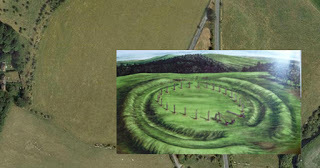
Archaeologists carrying out excavations at the Durrington Walls earthworks, just two miles from the world-famous stone circle of Stonehenge in Wiltshire, England, have discovered evidence of an enormous 500-meter diameter circle of timber posts. Experts have said the finding is of international significance.
In a world exclusive, The Independent has revealed that the newly-discovered wooden henge at Durrington Walls consisted of 200-300 timber posts measuring 6-7 meters in height and 60 – 70 centimeters in diameter. The posts were buried in 1.5-meter-deep holes, two of which have been fully excavated so far.
 The discovery was made just two miles from the world-famous stone circle of Stonehenge (
public domain
)Durrington Walls is the name given to a giant earthwork measuring around 1,640 feet (500 meters) in diameter and surrounded by a ditch of up to 54ft (16 meters) wide and a bank of more than three foot (1 meter) high. It is built on the same summer solstice alignment as Stonehenge. The enormous structure is believed to have formed a gigantic ceremonial complex in the Stonehenge landscape.
The discovery was made just two miles from the world-famous stone circle of Stonehenge (
public domain
)Durrington Walls is the name given to a giant earthwork measuring around 1,640 feet (500 meters) in diameter and surrounded by a ditch of up to 54ft (16 meters) wide and a bank of more than three foot (1 meter) high. It is built on the same summer solstice alignment as Stonehenge. The enormous structure is believed to have formed a gigantic ceremonial complex in the Stonehenge landscape.
The most intriguing aspect of the finding is that the construction of the wooden circle stopped abruptly before it was finished, around 2460 BC. The posts were removed from the holes, which were then filled in with blocks of chalk and then covered by a bank made of chalk rubble. In the bottom of one of the excavated post holes, archaeologists found a spade made from a cow’s shoulder blade.
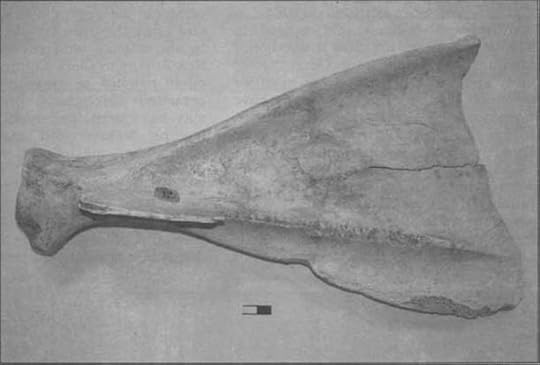 A tool made from a bison shoulder blade, which would be similar to the spade found in the bottom of one of the post holes. (
foresthistory.org
)According to The Independent, researchers believe this sudden cessation in construction is indicative of a dramatic change in religious and/or political direction, possibly due to the arrival in Britain around this time of the Beaker culture (2800 – 1800 BC). The Beaker culture is thought to have originated in either the Iberian Peninsula, the Netherlands or Central Europe and subsequently spread out across Western Europe. They are known for a particular pottery type they developed, but also a complex cultural phenomenon involving shared ideological, cultural and religious ideas.
A tool made from a bison shoulder blade, which would be similar to the spade found in the bottom of one of the post holes. (
foresthistory.org
)According to The Independent, researchers believe this sudden cessation in construction is indicative of a dramatic change in religious and/or political direction, possibly due to the arrival in Britain around this time of the Beaker culture (2800 – 1800 BC). The Beaker culture is thought to have originated in either the Iberian Peninsula, the Netherlands or Central Europe and subsequently spread out across Western Europe. They are known for a particular pottery type they developed, but also a complex cultural phenomenon involving shared ideological, cultural and religious ideas.
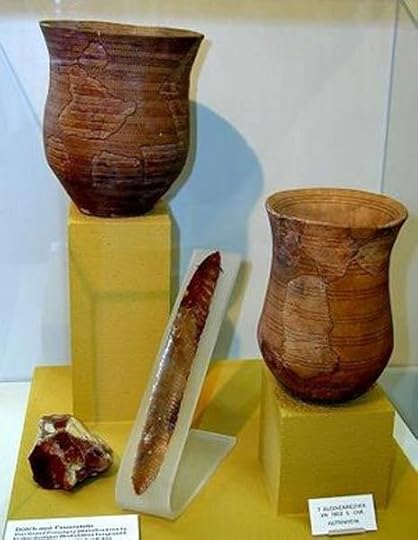 The distinctive Bell Beaker pottery drinking vessels shaped like an inverted bell (
public domain
)“It was as if the religious "revolutionaries" were trying, quite literally, to bury the past,” reports The Independent. “The question archaeologists will now seek to answer is whether it was the revolutionaries’ own past they were seeking to bury – or whether it was another group or cultural tradition’s past that was being consigned to the dustbin of prehistory.”
The distinctive Bell Beaker pottery drinking vessels shaped like an inverted bell (
public domain
)“It was as if the religious "revolutionaries" were trying, quite literally, to bury the past,” reports The Independent. “The question archaeologists will now seek to answer is whether it was the revolutionaries’ own past they were seeking to bury – or whether it was another group or cultural tradition’s past that was being consigned to the dustbin of prehistory.”
“The new discoveries at Durrington Walls reveal the previously unsuspected complexity of events in the area during the period when Stonehenge’s largest stones were being erected – and show just how politically and ideologically dynamic British society was at that particularly crucial stage in prehistory,” said Dr Nick Snashall, the senior National Trust archaeologist for the Stonehenge and Avebury World Heritage Site [via The Independent].
Top image: Main: An aerial photograph of Durrington Walls. In the North, West and South, a line of trees handily outlines the shape of the bank, a faint impression can be seen in the East, however, to the right of the road. The River Avon, and the area where the avenue connected it to Durrington Walls, can be seen in the bottom-right ( pegasusarchive.org ). Inset: An illustration of a similar wooden henge located at Cairnpapple Hill, Scotland .
By April Holloway
By April Holloway

Archaeologists carrying out excavations at the Durrington Walls earthworks, just two miles from the world-famous stone circle of Stonehenge in Wiltshire, England, have discovered evidence of an enormous 500-meter diameter circle of timber posts. Experts have said the finding is of international significance.
In a world exclusive, The Independent has revealed that the newly-discovered wooden henge at Durrington Walls consisted of 200-300 timber posts measuring 6-7 meters in height and 60 – 70 centimeters in diameter. The posts were buried in 1.5-meter-deep holes, two of which have been fully excavated so far.
 The discovery was made just two miles from the world-famous stone circle of Stonehenge (
public domain
)Durrington Walls is the name given to a giant earthwork measuring around 1,640 feet (500 meters) in diameter and surrounded by a ditch of up to 54ft (16 meters) wide and a bank of more than three foot (1 meter) high. It is built on the same summer solstice alignment as Stonehenge. The enormous structure is believed to have formed a gigantic ceremonial complex in the Stonehenge landscape.
The discovery was made just two miles from the world-famous stone circle of Stonehenge (
public domain
)Durrington Walls is the name given to a giant earthwork measuring around 1,640 feet (500 meters) in diameter and surrounded by a ditch of up to 54ft (16 meters) wide and a bank of more than three foot (1 meter) high. It is built on the same summer solstice alignment as Stonehenge. The enormous structure is believed to have formed a gigantic ceremonial complex in the Stonehenge landscape.The most intriguing aspect of the finding is that the construction of the wooden circle stopped abruptly before it was finished, around 2460 BC. The posts were removed from the holes, which were then filled in with blocks of chalk and then covered by a bank made of chalk rubble. In the bottom of one of the excavated post holes, archaeologists found a spade made from a cow’s shoulder blade.
 A tool made from a bison shoulder blade, which would be similar to the spade found in the bottom of one of the post holes. (
foresthistory.org
)According to The Independent, researchers believe this sudden cessation in construction is indicative of a dramatic change in religious and/or political direction, possibly due to the arrival in Britain around this time of the Beaker culture (2800 – 1800 BC). The Beaker culture is thought to have originated in either the Iberian Peninsula, the Netherlands or Central Europe and subsequently spread out across Western Europe. They are known for a particular pottery type they developed, but also a complex cultural phenomenon involving shared ideological, cultural and religious ideas.
A tool made from a bison shoulder blade, which would be similar to the spade found in the bottom of one of the post holes. (
foresthistory.org
)According to The Independent, researchers believe this sudden cessation in construction is indicative of a dramatic change in religious and/or political direction, possibly due to the arrival in Britain around this time of the Beaker culture (2800 – 1800 BC). The Beaker culture is thought to have originated in either the Iberian Peninsula, the Netherlands or Central Europe and subsequently spread out across Western Europe. They are known for a particular pottery type they developed, but also a complex cultural phenomenon involving shared ideological, cultural and religious ideas. The distinctive Bell Beaker pottery drinking vessels shaped like an inverted bell (
public domain
)“It was as if the religious "revolutionaries" were trying, quite literally, to bury the past,” reports The Independent. “The question archaeologists will now seek to answer is whether it was the revolutionaries’ own past they were seeking to bury – or whether it was another group or cultural tradition’s past that was being consigned to the dustbin of prehistory.”
The distinctive Bell Beaker pottery drinking vessels shaped like an inverted bell (
public domain
)“It was as if the religious "revolutionaries" were trying, quite literally, to bury the past,” reports The Independent. “The question archaeologists will now seek to answer is whether it was the revolutionaries’ own past they were seeking to bury – or whether it was another group or cultural tradition’s past that was being consigned to the dustbin of prehistory.”“The new discoveries at Durrington Walls reveal the previously unsuspected complexity of events in the area during the period when Stonehenge’s largest stones were being erected – and show just how politically and ideologically dynamic British society was at that particularly crucial stage in prehistory,” said Dr Nick Snashall, the senior National Trust archaeologist for the Stonehenge and Avebury World Heritage Site [via The Independent].
Top image: Main: An aerial photograph of Durrington Walls. In the North, West and South, a line of trees handily outlines the shape of the bank, a faint impression can be seen in the East, however, to the right of the road. The River Avon, and the area where the avenue connected it to Durrington Walls, can be seen in the bottom-right ( pegasusarchive.org ). Inset: An illustration of a similar wooden henge located at Cairnpapple Hill, Scotland .
By April Holloway
By April Holloway
Published on August 23, 2016 03:00
August 22, 2016
Q&A: When did Italian replace Latin as the language of Italy?
History Extra
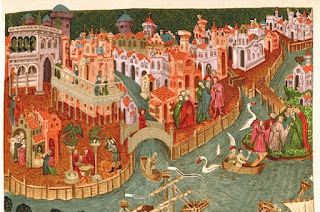 Venice in 1338. (Bridgeman Art Library)
Venice in 1338. (Bridgeman Art Library) Languages can literally die overnight when the last of their speakers dies, but the death of Latin was very different. After the fall of the Roman empire in the west in AD 476, Latin evolved into a wide variety of regional dialects now known as Romance vernaculars. In the early 14th century the Florentine poet Dante Alighieri reckoned that more than 1,000 such dialects were spoken in Italy. At the time of Dante, Latin was still used in literature, philosophy, medicine and other cultural or legal written documents. Dialects were spoken, but also used in writing: the earliest examples of vernacular writing in Italy date from the ninth century. The early 16th century saw the dialect used by Dante in his work replace Latin as the language of culture. We can thus say that modern Italian descends from 14th-century literary Florentine. Italy did not become a single nation until 1861, at which time less than 10 per cent of its citizens spoke the national language, Italian. Throughout the first half of the 20th century, Italy was a ‘diglossic country’ – one where a local dialect such as Neapolitan or Milanese was spoken at home while Italian was learned at school and used for official purposes. The First World War helped foster linguistic unification when, for the first time, soldiers from all over Italy met and talked to each other. The rise in literacy levels after the Second World War and the spread of mass media changed Italy into a bilingual nation, where Italian, increasingly the mother tongue of all Italians, coexists and interacts with the dialects of Italy.
Answered by Delia Bentley, senior lecturer at the University of Manchester.
Published on August 22, 2016 03:00
August 21, 2016
The hunt for the Tudor hitman
History Extra
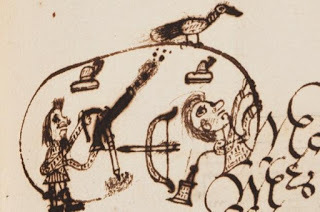
A contemporary illustration shows a man firing a gun. In 1530s England, the arquebus was the only firearm in general use – yet it was way too cumbersome to be the weapon employed in Robert Packington’s murder. © Mercer's Company
At around 6am on Monday 13 November 1536, Robert Packington left his house in London’s Cheapside – or just around the corner in Sopers Lane – to attend early Mass in the Mercers’ Chapel on the north side of West Cheap. His journey was a short one but, in all likelihood, Packington carried a lantern: the night was dark and smoke from a thousand chimneys, mingling with a mist from the Thames, reduced visibility to a few paces.
Packington’s route took him past the Great Conduit, a square building in the middle of Cheapside containing the fountain that provided the nearby houses with their water supply. As he crossed the thoroughfare, only a few metres from his destination, a single shot rang out and he fell dead upon the instant.
Almost as soon as Packington’s body hit the floor, the crowd that rapidly gathered around his corpse was asking questions. Why would someone want to eliminate one of London’s most respectable figures – Packington was not only a prominent merchant, and a leading light in the Worshipful Mercers’ Company, but also a member of parliament. Why did the assassin select such a busy part of London – a daily gathering point for unemployed men hoping to be hired as day labourers – to commit the crime?
And why did no one notice the gunman or his weapon? The only firearms in general use at the time were matchlock arquebuses – and these were hardly tailor-made for assassins wishing to carry out a swift, surgical strike. Arquebuses were more than a metre long and had to be held using both hands. The powder was ignited by means of a glowing match which would show up in the dark.
Even in the gloom of that November pre-dawn, anyone carrying, let alone using, such an unwieldy firearm would have attracted attention. Yet this assassin, apparently, stood a mere matter of yards from a crowd, put the gun to his shoulder, and pulled the trigger. There was a flash and an explosion. And yet no one saw him.
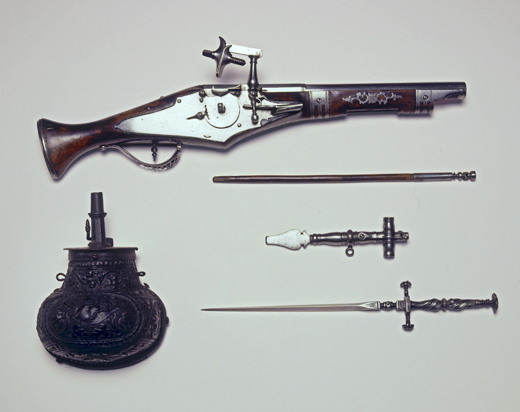
A wheellock pistol, the lethal new weapon used in a 1536 killing that seemed to be a professional 'hit'. © Bridgeman
The reason that the murderer was able to melt into the darkness was, as it transpires, that he wasn’t using an arquebus at all, but the much smaller, more discreet wheellock pistol. In fact, poor Robert Packington probably holds the dubious distinction of being the first person in England to be killed with a handgun.
By the time the autumn sun had dispelled the early mist, the shocking news of the merchant’s murder was all over town. And, by now, one more question was on everyone’s lips – and, four days later, that question was still unanswered. Writing to his master, Viscount Lisle, in Calais, Francis Hall reported: “The murderer that slew Mr Packington with a gun in Cheapside cannot be yet known.” Despite the offer of a large reward by the lord mayor, no one was brought to book for the crime.
But this did not mean that there were no suspicions. John Bale, the Protestant controversialist, writing a decade later, was sure that the instigators of the killing were the Catholic bishops – the “byfurked ordinaries”. Soon Edward Hall’s history of England from the reigns of Henry IV to Henry VIII – the Union of the Two Illustre Families of Lancaster and York (commonly called Hall’s Chronicle) – was on the bookstalls, containing a more detailed account of the incident. It added that because Packington had denounced “the covetousness and cruelty of the clergy” it was most likely that “by one of them [he was] thus shamefully murdered”.
Cruelty of the clergyBy the time Foxe wrote his Acts and Monuments of the Christian Religion (commonly known as the Book of Martyrs – first Latin edition 1559) specific perpetrators were in the frame.
But before we come onto those, we should consider the background to the murder. The year 1536 was an annus horribilis, the most tense and turbulent of Henry VIII’s reign.
The first ominous event was the death, in January, of Catharine of Aragon, the former queen, still much loved by many of Henry’s subjects. Scarcely had the memory of her passing begun to fade when news came that the king’s second wife, Anne Boleyn, had been arrested and was going to be executed.
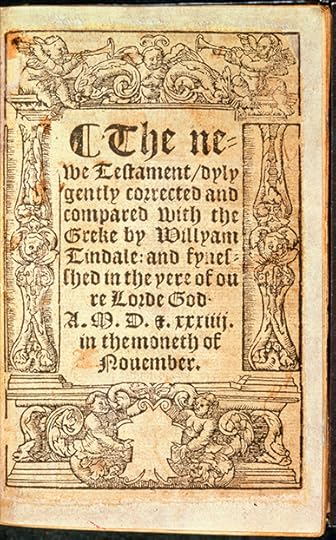
A copy of the New Testament translated into English by William Tyndale. Was Robert Packington targeted because he smuggled this banned text into England? © Bridgeman
Few mourned the death of the ‘French whore’ but many were troubled by the manner of her demise. The king had done so many terrible things, including making himself pope in England. What might he do next?
The answer was: begin dismantling the fabric of the nation’s religion by closing the smaller monasteries. Government preachers were put up in the pulpits to denounce Catholic practices. In response, bold spirits stood up in other churches to attack the ‘heretics’ now exercising power over the king – particularly Thomas Cromwell, Henry’s closest adviser, and archbishop Thomas Cranmer.
A rabid pamphlet war broke out between traditionalist and reformist parties. Neighbour accused neighbour of being a ‘papist’ or a ‘heretic’. There was widespread fear that insults would give way to violence. Cromwell even ordered that all priests must surrender any weapons they possessed.
Then, in October, the looming storm broke. News reached London that men in the Midlands and the north had risen in revolt against religious change and would soon be marching south. Henry and his court shut themselves up in Windsor Castle. Citizens feared that blood would soon be running in their streets. And so it was.
But why was it Robert Packington’s? A clue surely lies in the fact that he was a senior member of the Mercers’ Company, had studied at the Inns of Court and regularly sat at the House of Commons.
Now, if any Londoners resented the power of the clergy, it was the city’s merchants, lawyers and parliamentarians. Packington was an outspoken critic. But, in all probability, he was more – an evangelical activist engaged in smuggling William Tyndale’s banned translation of the New Testament and other heretical books into England. He was also, it seems, an associate of Cromwell, and carried messages between the minister and evangelical activists in Antwerp.
So, when Packington was brutally murdered few people were in any doubt that he was a victim of Catholic reactionaries, and that his death was a shot across Protestant bows fired by the senior clergy or even the bishop of London himself, John Stokesley.
John Foxe went a stage further in his Acts and Monuments of the Christian Religion. Stokesley, he averred, had paid someone 60 gold coins to undertake the murder. However, in his 1570 edition of the book, Foxe changed the name of the instigator. Now, he identified John Incent, canon of St Paul’s (and later dean), as the paymaster – a crime to which Incent had allegedly confessed on his deathbed in 1545. The actual hitman was now identified as an Italian.
To confuse the issue yet further, Holinshed’s Chronicles (1577) attributed the crime to an unnamed felon subsequently hanged at Banbury for an unrelated offence. Can we, 478 years later, make any sense of the conflicting evidence?
The attack has all the hallmarks of a professional ‘hit’. The weapon, the location, the timing all indicate a carefully planned assassination.
Hitmen do not come cheap. The early reports of a considerable fee having been paid certainly make sense. If the villain who actually pulled the trigger was the one who later paid for his crime at Banbury, we are left with two suspects as possible instigators of the atrocity. Foxe was – eventually – convinced about Incent’s deathbed confession. It was, he declared, attested “by men both of great credit and worshipful estimation”.

Dean John Incent allegedly confessed to the murder on his deathbed. © Getty Images
But was this middle-ranking priest capable of thinking up and putting into operation a cold-blooded murder?
Time, perhaps, for a little psychological profiling. Incent was a conservative and given to ecclesiastical in-fighting with more evangelically minded colleagues. But he had no reputation as a persecutor and he did not allow mere theology to stand in the way of his promotion: later he was one of the commissioners sent by Cromwell to dissolve monasteries. Moreover, if Incent believed that Packington was a dangerous heretic, why would his conscience be troubled about ridding the world of him?
Bishop Stokesley was a horse of a very different colour. He already had blood on his hands and actually boasted of having consigned over 30 heretics to the flames. He openly quarrelled with Cromwell and was particularly opposed to the minister’s pet project of promoting an English Bible. He was active in hunting down William Tyndale and having him arrested in Antwerp. The translator was burned as a heretic just five weeks before Packington’s death.
Here, I think, we may be at the crux of the matter. Stokesley believed passionately that the vernacular Bible should not be available in England. For years he had been fighting a losing battle against the illegal import of Tyndale’s New Testament. Anger and frustration could well have driven him to extreme measures. The bishop was clever enough, rich enough, powerful enough and ruthless enough to organise an attack on a Bible smuggler who was a confidant of that loathsome creature, Thomas Cromwell. Perhaps Foxe’s first impression was correct.
But then, what are we to make of Incent’s confession? Well, we are not obliged to believe that Stokesley acted alone. On the contrary, he would have needed trusted accomplices to help fine-tune the crime. If Incent was a mere sidekick who had supported his bishop’s plan to murder a prominent London citizen, he might well have felt the need to cleanse his soul before it followed that of Robert Packington into the presence of the Great Judge.
The assassin's weapon of choice
The pistol that killed Robert Packington made Europe's rulers decidely jumpy
The one fact mentioned in every early account of Robert Packington’s murder is that it was perpetrated “with a gun”. It was this that made the act shocking, cowardly and diabolical. The weapon referred to, and the only one that can have been used to kill Packington, was a wheellock pistol. Such a firearm was much shorter than an arquebus. It needed no lighted match because the powder was ignited by a spark struck from a flint. The weapon could be hidden beneath a cloak, brought out, fired one-handedly at close range, then as quickly concealed.
The wheellock introduced a new era of political assassination. Invented in the early 16th century, its potential was quickly recognised by European rulers. In 1518 the Holy Roman Emperor Maximillian I banned the manufacture and carrying of “self-igniting handguns that set themselves to firing”. Other heads of state were not slow to follow suit. By the 1530s wheellocks were still rare. They were complex and expensive pieces of kit carried by well-to-do, macho braggarts. Few people in London would ever have seen one. Small wonder that it was commonly believed that the murderer was a foreigner.
Did the clergy have form?
Those who held churchmen responsible for Packington's death were quick to call attention to a similar killing in 1514
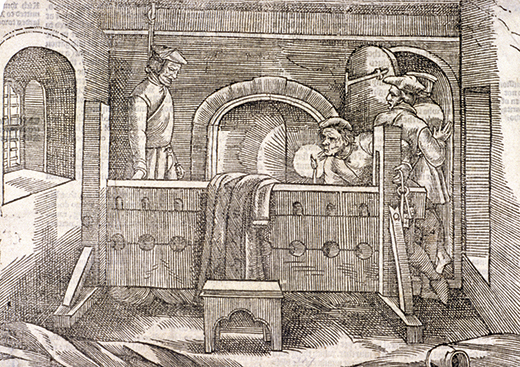
An illustration shows the hanging of merchant Richard Hunne at St Paul’s Cathedral. © Robin Mcmorran
Shortly after Robert Packington was slain on the streets of Cheapside, stories began circulating of another killing in England’s capital 22 years earlier.
In early 1537 an anonymous pamphlet, printed in Antwerp, was being avidly read on the streets of London, telling how one Richard Hunne had been locked up in the Lollards’ Tower of St Paul’s Cathedral and brutally murdered.
The pamphlet was no mere Protestant diatribe. It made public for the first time the complete coroner’s report and named three henchmen of Richard Fitzjames, then bishop of London, who had “feloniously strangled and smothered, and also the neck they did break of the said Richard Hunne… afterward… with the same girdle of the same Richard Hunne… after his death, upon a hook driven into… the wall of the prison… and so hanged him”.
Why was the story of this sensational crime revived more than two decades later? Why did it arouse fresh interest at this particular time? Because Hunne, like Packington, was a prominent merchant (a member of the Merchant Taylors’ Company) and an outspoken critic of the ecclesiastical hierarchy. He too, so it was alleged, had been violently silenced at the behest of the clergy.
The timing of the publication was no coincidence, and readers could not help remarking upon the parallels between the two killings.
Derek Wilson is the author of The First Horseman, a novel based upon the Packington affair, written under the name DK Wilson.
els between the two killings.
written under the name DK Wilson.

A contemporary illustration shows a man firing a gun. In 1530s England, the arquebus was the only firearm in general use – yet it was way too cumbersome to be the weapon employed in Robert Packington’s murder. © Mercer's Company
At around 6am on Monday 13 November 1536, Robert Packington left his house in London’s Cheapside – or just around the corner in Sopers Lane – to attend early Mass in the Mercers’ Chapel on the north side of West Cheap. His journey was a short one but, in all likelihood, Packington carried a lantern: the night was dark and smoke from a thousand chimneys, mingling with a mist from the Thames, reduced visibility to a few paces.
Packington’s route took him past the Great Conduit, a square building in the middle of Cheapside containing the fountain that provided the nearby houses with their water supply. As he crossed the thoroughfare, only a few metres from his destination, a single shot rang out and he fell dead upon the instant.
Almost as soon as Packington’s body hit the floor, the crowd that rapidly gathered around his corpse was asking questions. Why would someone want to eliminate one of London’s most respectable figures – Packington was not only a prominent merchant, and a leading light in the Worshipful Mercers’ Company, but also a member of parliament. Why did the assassin select such a busy part of London – a daily gathering point for unemployed men hoping to be hired as day labourers – to commit the crime?
And why did no one notice the gunman or his weapon? The only firearms in general use at the time were matchlock arquebuses – and these were hardly tailor-made for assassins wishing to carry out a swift, surgical strike. Arquebuses were more than a metre long and had to be held using both hands. The powder was ignited by means of a glowing match which would show up in the dark.
Even in the gloom of that November pre-dawn, anyone carrying, let alone using, such an unwieldy firearm would have attracted attention. Yet this assassin, apparently, stood a mere matter of yards from a crowd, put the gun to his shoulder, and pulled the trigger. There was a flash and an explosion. And yet no one saw him.

A wheellock pistol, the lethal new weapon used in a 1536 killing that seemed to be a professional 'hit'. © Bridgeman
The reason that the murderer was able to melt into the darkness was, as it transpires, that he wasn’t using an arquebus at all, but the much smaller, more discreet wheellock pistol. In fact, poor Robert Packington probably holds the dubious distinction of being the first person in England to be killed with a handgun.
By the time the autumn sun had dispelled the early mist, the shocking news of the merchant’s murder was all over town. And, by now, one more question was on everyone’s lips – and, four days later, that question was still unanswered. Writing to his master, Viscount Lisle, in Calais, Francis Hall reported: “The murderer that slew Mr Packington with a gun in Cheapside cannot be yet known.” Despite the offer of a large reward by the lord mayor, no one was brought to book for the crime.
But this did not mean that there were no suspicions. John Bale, the Protestant controversialist, writing a decade later, was sure that the instigators of the killing were the Catholic bishops – the “byfurked ordinaries”. Soon Edward Hall’s history of England from the reigns of Henry IV to Henry VIII – the Union of the Two Illustre Families of Lancaster and York (commonly called Hall’s Chronicle) – was on the bookstalls, containing a more detailed account of the incident. It added that because Packington had denounced “the covetousness and cruelty of the clergy” it was most likely that “by one of them [he was] thus shamefully murdered”.
Cruelty of the clergyBy the time Foxe wrote his Acts and Monuments of the Christian Religion (commonly known as the Book of Martyrs – first Latin edition 1559) specific perpetrators were in the frame.
But before we come onto those, we should consider the background to the murder. The year 1536 was an annus horribilis, the most tense and turbulent of Henry VIII’s reign.
The first ominous event was the death, in January, of Catharine of Aragon, the former queen, still much loved by many of Henry’s subjects. Scarcely had the memory of her passing begun to fade when news came that the king’s second wife, Anne Boleyn, had been arrested and was going to be executed.

A copy of the New Testament translated into English by William Tyndale. Was Robert Packington targeted because he smuggled this banned text into England? © Bridgeman
Few mourned the death of the ‘French whore’ but many were troubled by the manner of her demise. The king had done so many terrible things, including making himself pope in England. What might he do next?
The answer was: begin dismantling the fabric of the nation’s religion by closing the smaller monasteries. Government preachers were put up in the pulpits to denounce Catholic practices. In response, bold spirits stood up in other churches to attack the ‘heretics’ now exercising power over the king – particularly Thomas Cromwell, Henry’s closest adviser, and archbishop Thomas Cranmer.
A rabid pamphlet war broke out between traditionalist and reformist parties. Neighbour accused neighbour of being a ‘papist’ or a ‘heretic’. There was widespread fear that insults would give way to violence. Cromwell even ordered that all priests must surrender any weapons they possessed.
Then, in October, the looming storm broke. News reached London that men in the Midlands and the north had risen in revolt against religious change and would soon be marching south. Henry and his court shut themselves up in Windsor Castle. Citizens feared that blood would soon be running in their streets. And so it was.
But why was it Robert Packington’s? A clue surely lies in the fact that he was a senior member of the Mercers’ Company, had studied at the Inns of Court and regularly sat at the House of Commons.
Now, if any Londoners resented the power of the clergy, it was the city’s merchants, lawyers and parliamentarians. Packington was an outspoken critic. But, in all probability, he was more – an evangelical activist engaged in smuggling William Tyndale’s banned translation of the New Testament and other heretical books into England. He was also, it seems, an associate of Cromwell, and carried messages between the minister and evangelical activists in Antwerp.
So, when Packington was brutally murdered few people were in any doubt that he was a victim of Catholic reactionaries, and that his death was a shot across Protestant bows fired by the senior clergy or even the bishop of London himself, John Stokesley.
John Foxe went a stage further in his Acts and Monuments of the Christian Religion. Stokesley, he averred, had paid someone 60 gold coins to undertake the murder. However, in his 1570 edition of the book, Foxe changed the name of the instigator. Now, he identified John Incent, canon of St Paul’s (and later dean), as the paymaster – a crime to which Incent had allegedly confessed on his deathbed in 1545. The actual hitman was now identified as an Italian.
To confuse the issue yet further, Holinshed’s Chronicles (1577) attributed the crime to an unnamed felon subsequently hanged at Banbury for an unrelated offence. Can we, 478 years later, make any sense of the conflicting evidence?
The attack has all the hallmarks of a professional ‘hit’. The weapon, the location, the timing all indicate a carefully planned assassination.
Hitmen do not come cheap. The early reports of a considerable fee having been paid certainly make sense. If the villain who actually pulled the trigger was the one who later paid for his crime at Banbury, we are left with two suspects as possible instigators of the atrocity. Foxe was – eventually – convinced about Incent’s deathbed confession. It was, he declared, attested “by men both of great credit and worshipful estimation”.

Dean John Incent allegedly confessed to the murder on his deathbed. © Getty Images
But was this middle-ranking priest capable of thinking up and putting into operation a cold-blooded murder?
Time, perhaps, for a little psychological profiling. Incent was a conservative and given to ecclesiastical in-fighting with more evangelically minded colleagues. But he had no reputation as a persecutor and he did not allow mere theology to stand in the way of his promotion: later he was one of the commissioners sent by Cromwell to dissolve monasteries. Moreover, if Incent believed that Packington was a dangerous heretic, why would his conscience be troubled about ridding the world of him?
Bishop Stokesley was a horse of a very different colour. He already had blood on his hands and actually boasted of having consigned over 30 heretics to the flames. He openly quarrelled with Cromwell and was particularly opposed to the minister’s pet project of promoting an English Bible. He was active in hunting down William Tyndale and having him arrested in Antwerp. The translator was burned as a heretic just five weeks before Packington’s death.
Here, I think, we may be at the crux of the matter. Stokesley believed passionately that the vernacular Bible should not be available in England. For years he had been fighting a losing battle against the illegal import of Tyndale’s New Testament. Anger and frustration could well have driven him to extreme measures. The bishop was clever enough, rich enough, powerful enough and ruthless enough to organise an attack on a Bible smuggler who was a confidant of that loathsome creature, Thomas Cromwell. Perhaps Foxe’s first impression was correct.
But then, what are we to make of Incent’s confession? Well, we are not obliged to believe that Stokesley acted alone. On the contrary, he would have needed trusted accomplices to help fine-tune the crime. If Incent was a mere sidekick who had supported his bishop’s plan to murder a prominent London citizen, he might well have felt the need to cleanse his soul before it followed that of Robert Packington into the presence of the Great Judge.
The assassin's weapon of choice
The pistol that killed Robert Packington made Europe's rulers decidely jumpy
The one fact mentioned in every early account of Robert Packington’s murder is that it was perpetrated “with a gun”. It was this that made the act shocking, cowardly and diabolical. The weapon referred to, and the only one that can have been used to kill Packington, was a wheellock pistol. Such a firearm was much shorter than an arquebus. It needed no lighted match because the powder was ignited by a spark struck from a flint. The weapon could be hidden beneath a cloak, brought out, fired one-handedly at close range, then as quickly concealed.
The wheellock introduced a new era of political assassination. Invented in the early 16th century, its potential was quickly recognised by European rulers. In 1518 the Holy Roman Emperor Maximillian I banned the manufacture and carrying of “self-igniting handguns that set themselves to firing”. Other heads of state were not slow to follow suit. By the 1530s wheellocks were still rare. They were complex and expensive pieces of kit carried by well-to-do, macho braggarts. Few people in London would ever have seen one. Small wonder that it was commonly believed that the murderer was a foreigner.
Did the clergy have form?
Those who held churchmen responsible for Packington's death were quick to call attention to a similar killing in 1514

An illustration shows the hanging of merchant Richard Hunne at St Paul’s Cathedral. © Robin Mcmorran
Shortly after Robert Packington was slain on the streets of Cheapside, stories began circulating of another killing in England’s capital 22 years earlier.
In early 1537 an anonymous pamphlet, printed in Antwerp, was being avidly read on the streets of London, telling how one Richard Hunne had been locked up in the Lollards’ Tower of St Paul’s Cathedral and brutally murdered.
The pamphlet was no mere Protestant diatribe. It made public for the first time the complete coroner’s report and named three henchmen of Richard Fitzjames, then bishop of London, who had “feloniously strangled and smothered, and also the neck they did break of the said Richard Hunne… afterward… with the same girdle of the same Richard Hunne… after his death, upon a hook driven into… the wall of the prison… and so hanged him”.
Why was the story of this sensational crime revived more than two decades later? Why did it arouse fresh interest at this particular time? Because Hunne, like Packington, was a prominent merchant (a member of the Merchant Taylors’ Company) and an outspoken critic of the ecclesiastical hierarchy. He too, so it was alleged, had been violently silenced at the behest of the clergy.
The timing of the publication was no coincidence, and readers could not help remarking upon the parallels between the two killings.
Derek Wilson is the author of The First Horseman, a novel based upon the Packington affair, written under the name DK Wilson.
els between the two killings.
written under the name DK Wilson.
Published on August 21, 2016 03:00
August 20, 2016
Paid Sick Days and Physicians at Work: Ancient Egyptians had State-Supported Health Care
Ancient Origins
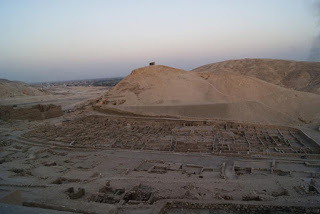
We might think of state supported health care as an innovation of the 20th century, but it’s a much older tradition than that. In fact, texts from a village dating back to Egypt’s New Kingdom period, about 3,100-3,600 years ago, suggest that in ancient Egypt there was a state-supported health care network designed to ensure that workers making the king’s tomb were productive.
Health care boosted productivity on the royal tombsThe village of Deir el-Medina was built for the workmen who made the royal tombs during the New Kingdom (1550-1070 BCE). During this period, kings were buried in the Valley of the Kings in a series of rock-cut tombs, not the enormous pyramids of the past. The village was purposely built close enough to the royal tomb to ensure that workers could hike there on a weekly basis.
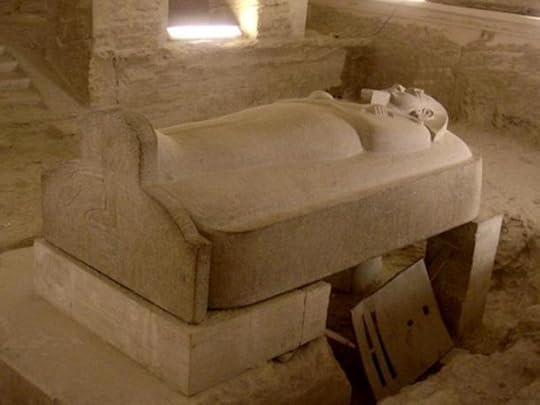 Stone sarcophagus of Merneptah in KV8. (
CC BY-SA 3.0
)These workmen were not what we normally picture when we think about the men who built and decorated ancient Egyptian royal tombs – they were highly skilled craftsmen. The workmen at Deir el-Medina were given a variety of amenities afforded only to those with the craftsmanship and knowledge necessary to work on something as important as the royal tomb.
Stone sarcophagus of Merneptah in KV8. (
CC BY-SA 3.0
)These workmen were not what we normally picture when we think about the men who built and decorated ancient Egyptian royal tombs – they were highly skilled craftsmen. The workmen at Deir el-Medina were given a variety of amenities afforded only to those with the craftsmanship and knowledge necessary to work on something as important as the royal tomb.
New study sheds light into ancient Egyptian health care system at Deir el-MedinaPolish Archaeologists Discover Rare Gift from Father of CleopatraThe village was allotted extra support: The Egyptian state paid them monthly wages in the form of grain and provided them with housing and servants to assist with tasks like washing laundry, grinding grain and porting water. Their families lived with them in the village, and their wives and children could also benefit from these provisions from the state.
Out sick? You’ll need a note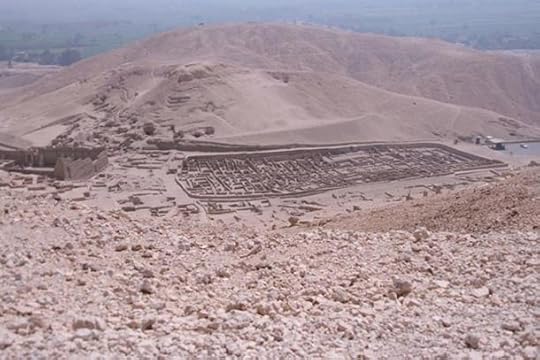 Deir el-Medina, the place the workers called home. (
CC BY 3.0
)Among these texts are numerous daily records detailing when and why individual workmen were absent from work. Nearly one-third of these absences occur when a workman was too sick to work. Yet, monthly ration distributions from Deir el-Medina are consistent enough to indicate that these workmen were paid even if they were out sick for several days.
Deir el-Medina, the place the workers called home. (
CC BY 3.0
)Among these texts are numerous daily records detailing when and why individual workmen were absent from work. Nearly one-third of these absences occur when a workman was too sick to work. Yet, monthly ration distributions from Deir el-Medina are consistent enough to indicate that these workmen were paid even if they were out sick for several days.
These texts also identify a workman on the crew designated as the swnw, physician. The physician was given an assistant and both were allotted days off to prepare medicine and take care of colleagues. The Egyptian state even gave the physician extra rations as payment for his services to the community of Deir el-Medina.
This physician would have most likely treated the workmen with remedies and incantations found in his medical papyrus. About a dozen extensive medical papyri have been identified from ancient Egypt, including one set from Deir el-Medina.
These texts were a kind of reference book for the ancient Egyptian medical practitioner, listing individual treatments for a variety of ailments. The longest of these, Papyrus Ebers, contains over 800 treatments covering anything from eye problems to digestive disorders. As an example, one treatment for intestinal worms requires the physician to cook the cores of dates and colocynth, a desert plant, together in sweet beer. He then sieved the warm liquid and gave it to the patient to drink for four days.
 A sample of the Papyrus Ebers. (
Public Domain
)Just like today, some of these ancient Egyptian medical treatments required expensive and rare ingredients that limited who could actually afford to be treated, but the most frequent ingredients found in these texts tended to be common household items like honey and grease. One text from Deir el-Medina indicates that the state rationed out common ingredients to a few men in the workforce so that they could be shared among the workers.
A sample of the Papyrus Ebers. (
Public Domain
)Just like today, some of these ancient Egyptian medical treatments required expensive and rare ingredients that limited who could actually afford to be treated, but the most frequent ingredients found in these texts tended to be common household items like honey and grease. One text from Deir el-Medina indicates that the state rationed out common ingredients to a few men in the workforce so that they could be shared among the workers.
Despite paid sick leave, medical rations and a state-supported physician, it is clear that in some cases the workmen were actually working through their illnesses.
Leaving a Mark: Elaborate Tattoos Found on 3,000-Year-Old Egyptian MummyThe Turin Papyrus: The Oldest Topographical and Geological Egyptian MapThe Egyptian Dream BookFor example, in one text, the workman Merysekhmet attempted to go to work after being sick. The text tells us that he descended to the King’s Tomb on two consecutive days, but was unable to work. He then hiked back to the village of Deir el-Medina where he stayed for the next ten days until he was able to work again. Though short, these hikes were steep: the trip from Deir el-Medina to the royal tomb involved an ascent greater than climbing to the top of the Great Pyramid. Merysekhmet’s movements across the Theban valleys were likely at the expense of his own health.
This suggests that sick days and medical care were not magnanimous gestures of the Egyptian state, but were rather calculated health care provisions designed to ensure that men like Merysekhmet were healthy enough to work.
Family was a social safety netIn cases where these provisions from the state were not enough, the residents of Deir el-Medina turned to each other. Personal letters from the site indicate that family members were expected to take care of each other by providing clothing and food, especially when a relative was sick. These documents show us that caretaking was a reciprocal relationship between direct family members, regardless of gender or age. Children were expected to take care of both parents just as parents were expected to take care of all of their children.
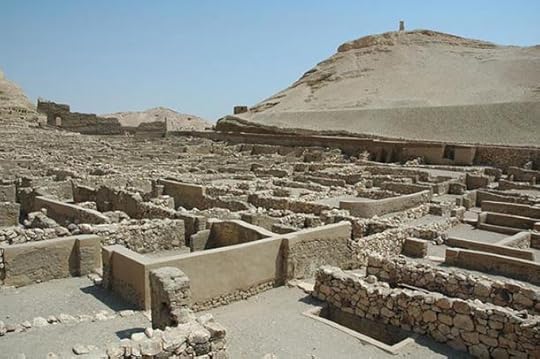 Ancient Egyptian workmans village "deir el-medina (
CC BY-SA 3.0
) When family members neglected these responsibilities, there were fiscal and social consequences. In her will, the villager Naunakhte indicates that even though she was a dedicated mother to all of her children, four of them abandoned her in her old age. She admonishes them and disinherits them from her will, punishing them financially, but also shaming them in a public document made in front of the most senior members of the Deir el-Medina community.
Ancient Egyptian workmans village "deir el-medina (
CC BY-SA 3.0
) When family members neglected these responsibilities, there were fiscal and social consequences. In her will, the villager Naunakhte indicates that even though she was a dedicated mother to all of her children, four of them abandoned her in her old age. She admonishes them and disinherits them from her will, punishing them financially, but also shaming them in a public document made in front of the most senior members of the Deir el-Medina community.
This shows us that health care at Deir el-Medina was a system with overlying networks of care provided through the state and the community. While workmen counted on the state for paid sick leave, a physician, and even medical ingredients, they were equally dependent on their loved ones for the care necessary to thrive in ancient Egypt.
Top image: The village of Deir el-Medina in the West Bank of Luxor, Egypt. Anne Austin, Author provided
The article ‘ Paid sick days and physicians at work: ancient Egyptians had state-supported health care ’ by Anne Austin was originally published on The Conversation and has been republished under a Creative Commons license

We might think of state supported health care as an innovation of the 20th century, but it’s a much older tradition than that. In fact, texts from a village dating back to Egypt’s New Kingdom period, about 3,100-3,600 years ago, suggest that in ancient Egypt there was a state-supported health care network designed to ensure that workers making the king’s tomb were productive.
Health care boosted productivity on the royal tombsThe village of Deir el-Medina was built for the workmen who made the royal tombs during the New Kingdom (1550-1070 BCE). During this period, kings were buried in the Valley of the Kings in a series of rock-cut tombs, not the enormous pyramids of the past. The village was purposely built close enough to the royal tomb to ensure that workers could hike there on a weekly basis.
 Stone sarcophagus of Merneptah in KV8. (
CC BY-SA 3.0
)These workmen were not what we normally picture when we think about the men who built and decorated ancient Egyptian royal tombs – they were highly skilled craftsmen. The workmen at Deir el-Medina were given a variety of amenities afforded only to those with the craftsmanship and knowledge necessary to work on something as important as the royal tomb.
Stone sarcophagus of Merneptah in KV8. (
CC BY-SA 3.0
)These workmen were not what we normally picture when we think about the men who built and decorated ancient Egyptian royal tombs – they were highly skilled craftsmen. The workmen at Deir el-Medina were given a variety of amenities afforded only to those with the craftsmanship and knowledge necessary to work on something as important as the royal tomb.New study sheds light into ancient Egyptian health care system at Deir el-MedinaPolish Archaeologists Discover Rare Gift from Father of CleopatraThe village was allotted extra support: The Egyptian state paid them monthly wages in the form of grain and provided them with housing and servants to assist with tasks like washing laundry, grinding grain and porting water. Their families lived with them in the village, and their wives and children could also benefit from these provisions from the state.
Out sick? You’ll need a note
 Deir el-Medina, the place the workers called home. (
CC BY 3.0
)Among these texts are numerous daily records detailing when and why individual workmen were absent from work. Nearly one-third of these absences occur when a workman was too sick to work. Yet, monthly ration distributions from Deir el-Medina are consistent enough to indicate that these workmen were paid even if they were out sick for several days.
Deir el-Medina, the place the workers called home. (
CC BY 3.0
)Among these texts are numerous daily records detailing when and why individual workmen were absent from work. Nearly one-third of these absences occur when a workman was too sick to work. Yet, monthly ration distributions from Deir el-Medina are consistent enough to indicate that these workmen were paid even if they were out sick for several days.These texts also identify a workman on the crew designated as the swnw, physician. The physician was given an assistant and both were allotted days off to prepare medicine and take care of colleagues. The Egyptian state even gave the physician extra rations as payment for his services to the community of Deir el-Medina.
This physician would have most likely treated the workmen with remedies and incantations found in his medical papyrus. About a dozen extensive medical papyri have been identified from ancient Egypt, including one set from Deir el-Medina.
These texts were a kind of reference book for the ancient Egyptian medical practitioner, listing individual treatments for a variety of ailments. The longest of these, Papyrus Ebers, contains over 800 treatments covering anything from eye problems to digestive disorders. As an example, one treatment for intestinal worms requires the physician to cook the cores of dates and colocynth, a desert plant, together in sweet beer. He then sieved the warm liquid and gave it to the patient to drink for four days.
 A sample of the Papyrus Ebers. (
Public Domain
)Just like today, some of these ancient Egyptian medical treatments required expensive and rare ingredients that limited who could actually afford to be treated, but the most frequent ingredients found in these texts tended to be common household items like honey and grease. One text from Deir el-Medina indicates that the state rationed out common ingredients to a few men in the workforce so that they could be shared among the workers.
A sample of the Papyrus Ebers. (
Public Domain
)Just like today, some of these ancient Egyptian medical treatments required expensive and rare ingredients that limited who could actually afford to be treated, but the most frequent ingredients found in these texts tended to be common household items like honey and grease. One text from Deir el-Medina indicates that the state rationed out common ingredients to a few men in the workforce so that they could be shared among the workers.Despite paid sick leave, medical rations and a state-supported physician, it is clear that in some cases the workmen were actually working through their illnesses.
Leaving a Mark: Elaborate Tattoos Found on 3,000-Year-Old Egyptian MummyThe Turin Papyrus: The Oldest Topographical and Geological Egyptian MapThe Egyptian Dream BookFor example, in one text, the workman Merysekhmet attempted to go to work after being sick. The text tells us that he descended to the King’s Tomb on two consecutive days, but was unable to work. He then hiked back to the village of Deir el-Medina where he stayed for the next ten days until he was able to work again. Though short, these hikes were steep: the trip from Deir el-Medina to the royal tomb involved an ascent greater than climbing to the top of the Great Pyramid. Merysekhmet’s movements across the Theban valleys were likely at the expense of his own health.
This suggests that sick days and medical care were not magnanimous gestures of the Egyptian state, but were rather calculated health care provisions designed to ensure that men like Merysekhmet were healthy enough to work.
Family was a social safety netIn cases where these provisions from the state were not enough, the residents of Deir el-Medina turned to each other. Personal letters from the site indicate that family members were expected to take care of each other by providing clothing and food, especially when a relative was sick. These documents show us that caretaking was a reciprocal relationship between direct family members, regardless of gender or age. Children were expected to take care of both parents just as parents were expected to take care of all of their children.
 Ancient Egyptian workmans village "deir el-medina (
CC BY-SA 3.0
) When family members neglected these responsibilities, there were fiscal and social consequences. In her will, the villager Naunakhte indicates that even though she was a dedicated mother to all of her children, four of them abandoned her in her old age. She admonishes them and disinherits them from her will, punishing them financially, but also shaming them in a public document made in front of the most senior members of the Deir el-Medina community.
Ancient Egyptian workmans village "deir el-medina (
CC BY-SA 3.0
) When family members neglected these responsibilities, there were fiscal and social consequences. In her will, the villager Naunakhte indicates that even though she was a dedicated mother to all of her children, four of them abandoned her in her old age. She admonishes them and disinherits them from her will, punishing them financially, but also shaming them in a public document made in front of the most senior members of the Deir el-Medina community.This shows us that health care at Deir el-Medina was a system with overlying networks of care provided through the state and the community. While workmen counted on the state for paid sick leave, a physician, and even medical ingredients, they were equally dependent on their loved ones for the care necessary to thrive in ancient Egypt.
Top image: The village of Deir el-Medina in the West Bank of Luxor, Egypt. Anne Austin, Author provided
The article ‘ Paid sick days and physicians at work: ancient Egyptians had state-supported health care ’ by Anne Austin was originally published on The Conversation and has been republished under a Creative Commons license
Published on August 20, 2016 03:00
August 19, 2016
Putting the Horse Before the Chariot: Gorgeous Ancient Roman Mosaics Unearthed in Cyprus
Ancient Origins
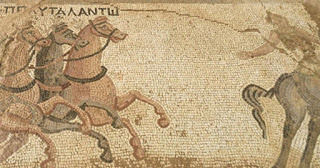
A mosaic floor dating back to the 4th century AD has been unearthed in Cyprus. It illustrates scenes from chariot races in the hippodrome. Previously, another team working on the island found a mosaic showing scenes from the labors of Hercules. That mosaic is two centuries older than the one that was just excavated. Together, these mosaics provide a fascinating glimpse into the interests of ancient Romans that once lived on the Mediterranean island.
The chariot race mosaic was discovered in Akaki village, 19 miles (30.58 km) from the capital city of Cyprus – Nicosia. The mosaic’s existence had been known since 1938 when farmers discovered a small piece of the floor. However, it took 80 years until researchers decided to unearth the whole thing. This magnificent find made the village world famous. The mosaic is the only one of its kind in Cyprus and one of just seven in the world.
According to the Daily Mail, the floor is 11 meters (36 ft.) long and 4 meters (13 ft.) wide. It probably belonged to a nobleman who lived there during the Roman domination on Cyprus. The mosaic is stunningly detailed, decorated with complete race scenes of four charioteers, each being drawn by a team of four horses.
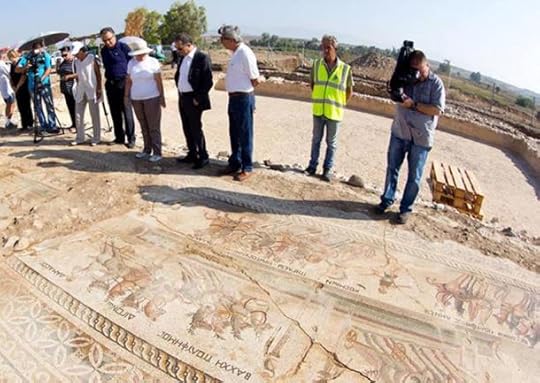 Officials examining part of the mosaic found in Akaki village. (
Cyprus Mail
)The researchers believe that the mosaic shows different factions that competed in ancient Rome. They say that the hippodrome was a very meaningful place in ancient Roman times and it was a center for many events. It was not only a place for sports competitions, but also where the emperor appeared in front of the people and projected his power.
Officials examining part of the mosaic found in Akaki village. (
Cyprus Mail
)The researchers believe that the mosaic shows different factions that competed in ancient Rome. They say that the hippodrome was a very meaningful place in ancient Roman times and it was a center for many events. It was not only a place for sports competitions, but also where the emperor appeared in front of the people and projected his power.
The name “hippodrome” comes from the Greek words hippos ('horse') and dromos ('course'). It was sort of an open-air stadium, used in ancient Greece, Rome, and Byzantine civilizations. The hippodrome was used for many different purposes, but the most spectacular ones were the chariot and horse races.
Discovery Reveals Cyprus was part of Neolithic Revolution3,500-Year-Old Tomb with Remains of 17 Elites and Precious Artifacts Found in Cyprus4,000-year-old cosmetics shop found in Cyprus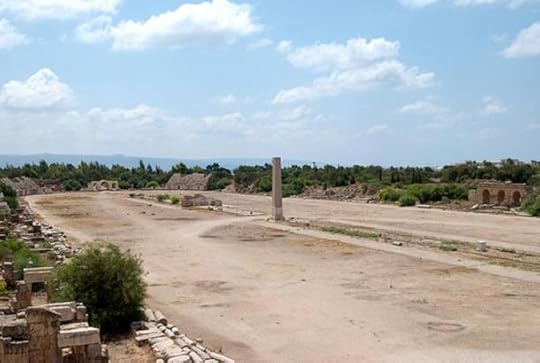 Ruins of a Roman hippodrome in Tyre, Lebanon. (
Peripitus
/CC BY SA 3.0
)
Inscriptions are seen near the four charioteers depicted in the mosaic which are believed to be their names and the name of one of the horses as well.
Ruins of a Roman hippodrome in Tyre, Lebanon. (
Peripitus
/CC BY SA 3.0
)
Inscriptions are seen near the four charioteers depicted in the mosaic which are believed to be their names and the name of one of the horses as well.
Three cones can also be seen along the circular arena. According to Daily Mail, each one of them is “topped with egg-shaped objects, and three columns seen in the distance hold up dolphin figures with what appears like water flowing from them.”
As Marina Ieronymidou, the director of the Department of Antiquities told journalists during a press conference: “It is an extremely important finding, because of the technique and because of the theme. It is unique in Cyprus since the presence of this mosaic floor in a remote inland area provides important new information on that period in Cyprus and adds to our knowledge of the use of mosaic floors on the island.''
The floor reveals some information about the interests of the upper classes during the 4th century AD. It sheds light on the ancient past of the island's interior and shows that the Roman nobles still cultivated Roman cultural traditions in the 4th century.
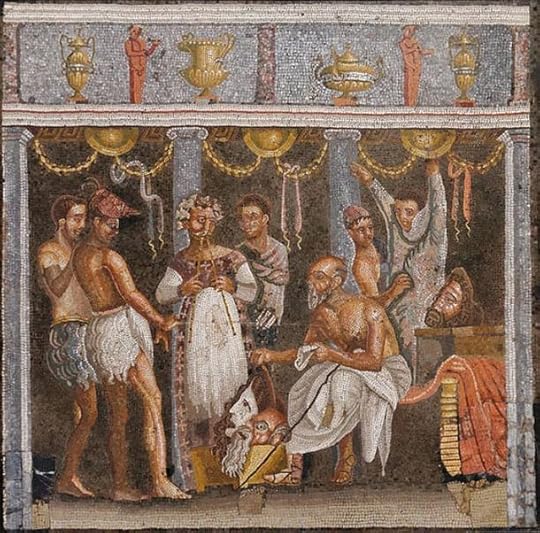 Choregos and actors, Roman mosaic. From the House of the Tragic Poet (VI, 8, 3), Pompeii. (Public Domain)In July 2016, a team of researchers working in the coastal city of Larnaca in Cyprus discovered a 2nd century floor showing the labors of Hercules. It is 20 meters (65 ft.) long and seems to be a part of some ancient baths. It depicts Hercules performing his feats of strength as penance for killing his wife and children in a rage. Larnaca was an ancient city state of Kition, and it was destroyed by earthquakes in the 4th century AD.
Choregos and actors, Roman mosaic. From the House of the Tragic Poet (VI, 8, 3), Pompeii. (Public Domain)In July 2016, a team of researchers working in the coastal city of Larnaca in Cyprus discovered a 2nd century floor showing the labors of Hercules. It is 20 meters (65 ft.) long and seems to be a part of some ancient baths. It depicts Hercules performing his feats of strength as penance for killing his wife and children in a rage. Larnaca was an ancient city state of Kition, and it was destroyed by earthquakes in the 4th century AD.
2,400-Year-Old Aristocrat Family Tomb Uncovered in Cyprus Sheds Light on Ancient SoloiThe Ancient Ruins of Salamis, the Once Thriving Port City of CyprusAncient Greek amulet with strange palindrome inscription discovered in Cyprus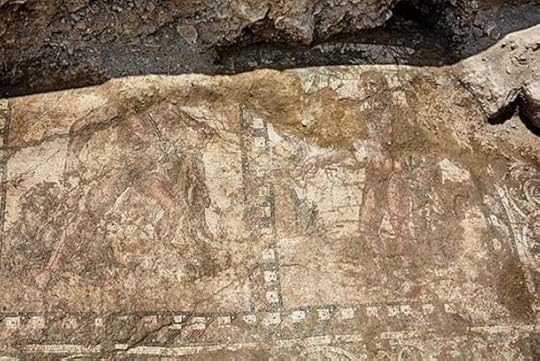 A 2nd century mosaic showing the labors of Hercules that was discovered in Larnaca. (Cyprus Department of Antiquities)Cyprus was a very attractive place for the nobles during the Roman Empire’s domination of the Mediterranean. Arguably, the most fascinating site on Cyprus is the ancient city of Salamis, which was settled circa 11th century BC. The motif of the chariot also appeared in tombs that were discovered there, showing a continued interest in chariot-related traditions. As April Holloway from Ancient Origins explained in her article from April 6, 2015:
A 2nd century mosaic showing the labors of Hercules that was discovered in Larnaca. (Cyprus Department of Antiquities)Cyprus was a very attractive place for the nobles during the Roman Empire’s domination of the Mediterranean. Arguably, the most fascinating site on Cyprus is the ancient city of Salamis, which was settled circa 11th century BC. The motif of the chariot also appeared in tombs that were discovered there, showing a continued interest in chariot-related traditions. As April Holloway from Ancient Origins explained in her article from April 6, 2015:
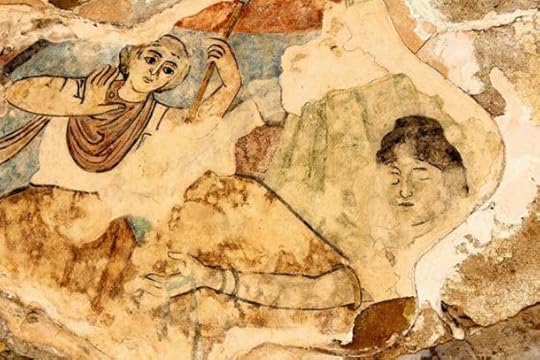 Example of mosaic found at the Roman ruins of Salamis. (John Higgins/
Flickr
)These discoveries help show how the Roman nobility’s interests transformed over the ages. While some motifs remained popular over the years, others were introduced or altered to reflect current practices.
Example of mosaic found at the Roman ruins of Salamis. (John Higgins/
Flickr
)These discoveries help show how the Roman nobility’s interests transformed over the ages. While some motifs remained popular over the years, others were introduced or altered to reflect current practices.
Top Image: Detail of the chariot race mosaic. Source: Pavlos Vrionides
By Natalia Klimczak

A mosaic floor dating back to the 4th century AD has been unearthed in Cyprus. It illustrates scenes from chariot races in the hippodrome. Previously, another team working on the island found a mosaic showing scenes from the labors of Hercules. That mosaic is two centuries older than the one that was just excavated. Together, these mosaics provide a fascinating glimpse into the interests of ancient Romans that once lived on the Mediterranean island.
The chariot race mosaic was discovered in Akaki village, 19 miles (30.58 km) from the capital city of Cyprus – Nicosia. The mosaic’s existence had been known since 1938 when farmers discovered a small piece of the floor. However, it took 80 years until researchers decided to unearth the whole thing. This magnificent find made the village world famous. The mosaic is the only one of its kind in Cyprus and one of just seven in the world.
According to the Daily Mail, the floor is 11 meters (36 ft.) long and 4 meters (13 ft.) wide. It probably belonged to a nobleman who lived there during the Roman domination on Cyprus. The mosaic is stunningly detailed, decorated with complete race scenes of four charioteers, each being drawn by a team of four horses.
 Officials examining part of the mosaic found in Akaki village. (
Cyprus Mail
)The researchers believe that the mosaic shows different factions that competed in ancient Rome. They say that the hippodrome was a very meaningful place in ancient Roman times and it was a center for many events. It was not only a place for sports competitions, but also where the emperor appeared in front of the people and projected his power.
Officials examining part of the mosaic found in Akaki village. (
Cyprus Mail
)The researchers believe that the mosaic shows different factions that competed in ancient Rome. They say that the hippodrome was a very meaningful place in ancient Roman times and it was a center for many events. It was not only a place for sports competitions, but also where the emperor appeared in front of the people and projected his power.The name “hippodrome” comes from the Greek words hippos ('horse') and dromos ('course'). It was sort of an open-air stadium, used in ancient Greece, Rome, and Byzantine civilizations. The hippodrome was used for many different purposes, but the most spectacular ones were the chariot and horse races.
Discovery Reveals Cyprus was part of Neolithic Revolution3,500-Year-Old Tomb with Remains of 17 Elites and Precious Artifacts Found in Cyprus4,000-year-old cosmetics shop found in Cyprus
 Ruins of a Roman hippodrome in Tyre, Lebanon. (
Peripitus
/CC BY SA 3.0
)
Inscriptions are seen near the four charioteers depicted in the mosaic which are believed to be their names and the name of one of the horses as well.
Ruins of a Roman hippodrome in Tyre, Lebanon. (
Peripitus
/CC BY SA 3.0
)
Inscriptions are seen near the four charioteers depicted in the mosaic which are believed to be their names and the name of one of the horses as well.Three cones can also be seen along the circular arena. According to Daily Mail, each one of them is “topped with egg-shaped objects, and three columns seen in the distance hold up dolphin figures with what appears like water flowing from them.”
As Marina Ieronymidou, the director of the Department of Antiquities told journalists during a press conference: “It is an extremely important finding, because of the technique and because of the theme. It is unique in Cyprus since the presence of this mosaic floor in a remote inland area provides important new information on that period in Cyprus and adds to our knowledge of the use of mosaic floors on the island.''
The floor reveals some information about the interests of the upper classes during the 4th century AD. It sheds light on the ancient past of the island's interior and shows that the Roman nobles still cultivated Roman cultural traditions in the 4th century.
 Choregos and actors, Roman mosaic. From the House of the Tragic Poet (VI, 8, 3), Pompeii. (Public Domain)In July 2016, a team of researchers working in the coastal city of Larnaca in Cyprus discovered a 2nd century floor showing the labors of Hercules. It is 20 meters (65 ft.) long and seems to be a part of some ancient baths. It depicts Hercules performing his feats of strength as penance for killing his wife and children in a rage. Larnaca was an ancient city state of Kition, and it was destroyed by earthquakes in the 4th century AD.
Choregos and actors, Roman mosaic. From the House of the Tragic Poet (VI, 8, 3), Pompeii. (Public Domain)In July 2016, a team of researchers working in the coastal city of Larnaca in Cyprus discovered a 2nd century floor showing the labors of Hercules. It is 20 meters (65 ft.) long and seems to be a part of some ancient baths. It depicts Hercules performing his feats of strength as penance for killing his wife and children in a rage. Larnaca was an ancient city state of Kition, and it was destroyed by earthquakes in the 4th century AD.2,400-Year-Old Aristocrat Family Tomb Uncovered in Cyprus Sheds Light on Ancient SoloiThe Ancient Ruins of Salamis, the Once Thriving Port City of CyprusAncient Greek amulet with strange palindrome inscription discovered in Cyprus
 A 2nd century mosaic showing the labors of Hercules that was discovered in Larnaca. (Cyprus Department of Antiquities)Cyprus was a very attractive place for the nobles during the Roman Empire’s domination of the Mediterranean. Arguably, the most fascinating site on Cyprus is the ancient city of Salamis, which was settled circa 11th century BC. The motif of the chariot also appeared in tombs that were discovered there, showing a continued interest in chariot-related traditions. As April Holloway from Ancient Origins explained in her article from April 6, 2015:
A 2nd century mosaic showing the labors of Hercules that was discovered in Larnaca. (Cyprus Department of Antiquities)Cyprus was a very attractive place for the nobles during the Roman Empire’s domination of the Mediterranean. Arguably, the most fascinating site on Cyprus is the ancient city of Salamis, which was settled circa 11th century BC. The motif of the chariot also appeared in tombs that were discovered there, showing a continued interest in chariot-related traditions. As April Holloway from Ancient Origins explained in her article from April 6, 2015:“Salamis was a large city in ancient times. It served many dominant groups over the course of its history, including Assyrians, Egyptians, Persians, and Romans. According to Homeric legend, Salamis was founded by archer Teucer from the Trojan War […] The city contains large, arched tombs, dating back to the 7th and 8th century, BC.
As with any culture, the tombs give a glimpse into the social hierarchy of the ancient residents of the city. Royalty was not buried within the tombs, as they were reserved for nobles. The tombs were constructed from large ashlars (fine cut masonry) and mud brick. When one was buried, the horse and chariot from the procession would be sacrificed in front of the tomb. The sacrifice of a horse in this method was a common ritual for funerals. Tombs also included grave good such as weapons and jewelry.”
 Example of mosaic found at the Roman ruins of Salamis. (John Higgins/
Flickr
)These discoveries help show how the Roman nobility’s interests transformed over the ages. While some motifs remained popular over the years, others were introduced or altered to reflect current practices.
Example of mosaic found at the Roman ruins of Salamis. (John Higgins/
Flickr
)These discoveries help show how the Roman nobility’s interests transformed over the ages. While some motifs remained popular over the years, others were introduced or altered to reflect current practices.Top Image: Detail of the chariot race mosaic. Source: Pavlos Vrionides
By Natalia Klimczak
Published on August 19, 2016 03:00
August 18, 2016
A time traveller’s guide to medieval shopping
History Extra
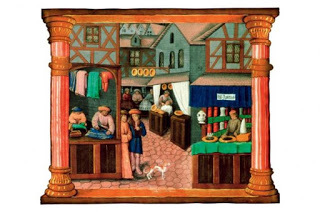 This image shows a 15th-century continental town (taken from the Livre de Gouvernement des Princes by Gilles de Rome). It shows an apothecary shop well-stocked with red and white jars of medicinal substances; a barber using a cut-throat razor; and a tailor and his apprentice working on clothes. Credit Bridgeman Art Library The poet WH Auden once suggested that, in order to understand your own country, you need to have lived in at least two others. But what about your own time? By the same reckoning, you need to have experienced at least two other centuries. This presents us with some difficulties. But through historical research, coming to terms with another century is not impossible.
This image shows a 15th-century continental town (taken from the Livre de Gouvernement des Princes by Gilles de Rome). It shows an apothecary shop well-stocked with red and white jars of medicinal substances; a barber using a cut-throat razor; and a tailor and his apprentice working on clothes. Credit Bridgeman Art Library The poet WH Auden once suggested that, in order to understand your own country, you need to have lived in at least two others. But what about your own time? By the same reckoning, you need to have experienced at least two other centuries. This presents us with some difficulties. But through historical research, coming to terms with another century is not impossible.We can approach the past as if it really is ‘a foreign country’ – somewhere we might visit. And we do not actually need to travel in time to appreciate it – just the idea of visiting the past allows us to see life differently, and more immediately. Come shopping in the late 14th century and see for yourself.
The marketplace“Ribs of beef and many a pie!” you hear someone call over your shoulder. Turning, you see a young lad walking through the crowd bearing a tray laden with wooden bowls of cooked meats from a local shop.
All around him people are moving, gesturing, talking. So many have come in from the surrounding villages that this town of about 3,000 inhabitants is today thronged with twice as many. Here are men in knee-length brown tunics driving their cattle before them. Here are their wives in long kirtles with wimples around their heads and necks. Those men in short tunics and hoods are valets in a knight’s household. Those in long gowns with high collars and beaver-fur hats are wealthy merchants. Across the marketplace more peasants are leading in their flocks of sheep, or packhorses and carts loaded with crates of chickens.
Crowds are noisy. People are talking so much that chatter could almost be the whole purpose of the market – and in many ways it is. This is the one open public area in the town where people can meet and exchange information. When a company performs a mystery play, it is to the marketplace that they will drag the cart containing their stage, set and costumes. When the town crier rings his bell to address the people of the town, it is in the marketplace that the crowd will gather to hear him. The marketplace is the heart of any town: indeed, the very definition of a town is that it has a market.
What can you buy? Let’s start at the fishmongers’ stalls. You may have heard that many sorts of freshwater and sea fish are eaten in medieval England. Indeed, more than 150 species are consumed by the nobility and churchmen, drawn from their own fishponds as well as the rivers and seas.
But in most markets it is the popular varieties which you see glistening in the wet hay-filled crates. Mackerel, herring, lampreys, cod, eels, Aberdeen fish (cured salmon and herring), and stockfish (salt cod) are the most common varieties. Crabs and lobsters are transported live, in barrels. In season you will see fresh salmon – attracting the hefty price of four or five shillings each. A fresh turbot can cost even more, up to seven shillings.
Next we come to an area set aside for corn: sacks of wheat, barley, oats and rye are piled up, ready for sale to the townsmen. Then the space given over to livestock: goats, sheep, pigs and cows. A corner is devoted to garden produce – apples, pears, vegetables, garlic and herbs – yet the emphasis of a medieval diet is on meat, cheese and cereal crops. In a large town you will find spicerers selling such exotic commodities as pepper, cinnamon, cloves, nutmeg, liquorice, and many different types of sugar.
These are only for the wealthy. When your average skilled workman earns only two shillings (2s) in a week, he can hardly afford to spend four shillings (4s) on a pound of cloves or 20 pence (20d) on a pound of ginger.
The rest of the marketplace performs two functions. Producers come to sell fleeces, sacks of wool, tanned hides, furs, iron, steel and tin for resale further afield. The other function is to sell manufactured commodities to local people: brass and bronze cooking vessels, candlesticks and spurs, pewterware, woollen cloth, silk, linen, canvas, carts, rushes (for hall floors), glass, faggots, coal, nails, horse shoes and planks of wood.
Planks, you ask? Consider the difficulties of transporting a tree trunk to a saw pit, and then getting two men to saw it into planks with only a handsaw between them.
Everyone in medieval society is heavily dependent on each other for such supplies, and the marketplace is where all these interdependencies meet.
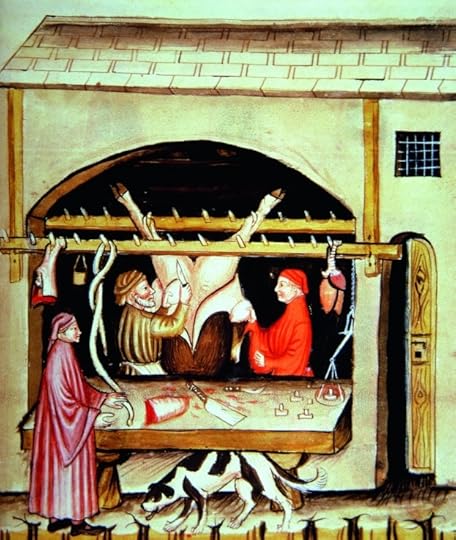
A vendor removes the udders from a cow in this contemporary depiction of a 14th-century butcher’s shop. (Bridgeman Art Library)
HagglingEssential items such as ale and bread have their prices fixed by law. Yet for almost everything that’s been manufactured you will have to negotiate. Caxton’s 15th-century dialogue book is based on a 14th-century language guide, and gives the following lesson in how to haggle with a cloth vendor:
“Dame, what hold ye the ell (45 inches) of this
cloth? Or what is worth the cloth whole?
In short, so to speak, how much the ell?”
“Sire, reason; ye shall have it good and cheap.”
“Yea, truly, for cattle. Dame, ye must me win.
Take heed what I shall pay.”
“Four shillings for the ell, if it please you.”
“For so much would I have good scarlet.”
“But I have some which is not of the best
which I would not give for seven shillings.”
“But this is no such cloth, of so much money,
that know ye well!”
“Sire, what is it worth?”
“Dame, it were worth to me well three shillings.”
“That is evil-boden.”
“But say certainly how shall I have it without
a part to leave?”
“I shall give it ye at one word: ye shall pay five
shillings, certainly if ye have them for so many
ells, for I will abate nothing.”
And so you open your purse, which hangs from the cords attached to your belt and find five shillings. Except that there is no shilling coin in the late 14th century. The smallest gold coins are the half-noble (3s 4d) and the quarter-noble (1s 8d), so if you have one each of these, you can make up the sum. Alternatively you will have to make it up from the silver coins: groats (4d), half-groats, pennies, halfpence and farthings (¼d).
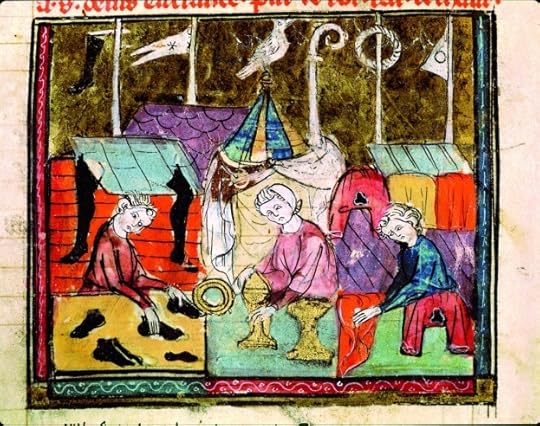
Merchants at work at the annual Lendit Fair, which was held near St Denis, Paris each June from the 12th century. (Credit Bridgeman Art Library)
RegulationsA well-run market is crucial to the standing of a town. Thus it is heavily regulated. The actual policing tends to be undertaken by the town’s bedels or bailiffs, who enforce regulations like “no horses may be left standing in the marketplace on market days” and “every man is to keep the street in front of his tenement clean”. Most towns have between 40 and 70 regulations, and those breaking them are taken to the borough court and fined.
There are reasons to be grateful for the supervision of trade. Short measures are a notorious problem, and turners normally have to swear to make wooden measures of the appropriate size. Clerks in borough courts will tell you of cooking pots being made out of soft metal and coated with brass, and loaves of bread baked with stones in them to make them up to the legally required weight.
Wool is stretched before it is woven, to make it go further (but then it shrinks). Pepper is sold damp, making it swell, weigh more, and rot sooner. Meat is sometimes sold even though it is putrid, wine even though it has turned sour, and bread when it has gone green.
If you are the victim of malpractice, go straight to the authorities. The perpetrator will be pilloried – literally. The pillory is the wooden board which clasps the guilty man’s head and hands, and shamefully exposes him to the insults of the crowd.
A butcher selling bad meat can expect to be dragged through the streets of the town on a hurdle and then placed in the pillory with the rotten meat burnt under him. A vintner caught selling foul wine is dragged to the pillory on a hurdle, forced to drink a draught of the offending liquor, and then set in the pillory where the remainder is poured over his head.
The sweetness of the revenge makes up for the sourness of the wine.
Shopping in the 14th century will often remind you of how much we have in common with our medieval forebears. It will likewise alert you to the huge differences between us. We are not the same as our ancestors. Look at how young they are – the median age is just 21 – and look at the meagre diet of the poor, their rotten teeth as they smile, their resilience in the face of death.
Consider how rough and smelly the streets are, and how small the sheep and cattle are in the marketplace. When a fight breaks out over some stolen goods, and the bedels rush to intervene, you may see how the spirit of the people is so similar to our own and yet how much the process of managing that spirit has changed. For if the stolen goods are of sufficient value, the thieves will be summarily tried and hanged the same day. This is what makes history so interesting – the differences between us across the centuries, as well as the similarities.
At dusk – just before the great gates of the city are closed for the night, and you see everyone leaving the adjacent taverns – you may begin to think that Auden was on to something. To understand ourselves, we must first see society differently – and to remember that history is the study of the living, not the dead.
FactsPrices in the 1390s*
Ale, ordinary: ¾d–1d per gallon
Wine from Bordeaux: 3d–4d per gallon
Bacon: 15d per side
Chicken: 2d each
Cod, fresh: 20d each
Sugar, loaf of: 18d per lb
Apples: 7d per hundred
Eggs: 33d for 425
A furred gown: 5s 4d
* Prices from the account books of Henry of Lancaster, Earl of Derby.
Wages/salaries in the 1390s
The king’s physician: £40 per year
Officers in the royal household: £20 per year
Mason: £8 per year (6d per day)
Carpenter: 4¼d per day
Thatcher: 4¼d per day
Labourer: 3¼d per day
Valets in a lord’s household: £1 10s per year
Manservant in a yeoman’s household: £1 per year
Maidservant in a yeoman’s household: 10s per year
In old money, there were 12 pence (d) to the shilling (s) and 20 shillings to the pound (£).
Published on August 18, 2016 03:00
August 17, 2016
Archaeologists May Have Discovered the Birthplace of King Arthur: Legends Come to Life?
Ancient Origins

The recent discovery of 1500-year-old ruins at Tintagel in south-west England has made headlines around the world. What appear to the be the walls of a Dark Age palace have been found in the exact place, and dating from the very time, King Arthur is said to have been born.
 The ruins of the upper mainland courtyards of Tintagel Castle, Cornwall. (
Kerry Garratt/CC BY SA 2.0
)
The ruins of the upper mainland courtyards of Tintagel Castle, Cornwall. (
Kerry Garratt/CC BY SA 2.0
) Ruins at Tintagel, England. (
CC BY 2.5
)During the 1130’s the British cleric Geoffrey of Monmouth wrote The History of the Kings of Britain, in which he tells us that Arthur was born in a castle on windswept, coastal cliffs just outside the village of Tintagel in the English county of Cornwall. According to the account, Arthur’s father to be, Uther Pendragon, falls for Igraine, the duchess of Cornwall, and Merlin makes him a magic potion to transform him into the likeness of her husband so the couple can make love in her residence at Tintagel. The plan works but with an unplanned consequence: the baby Arthur is conceived.
Ruins at Tintagel, England. (
CC BY 2.5
)During the 1130’s the British cleric Geoffrey of Monmouth wrote The History of the Kings of Britain, in which he tells us that Arthur was born in a castle on windswept, coastal cliffs just outside the village of Tintagel in the English county of Cornwall. According to the account, Arthur’s father to be, Uther Pendragon, falls for Igraine, the duchess of Cornwall, and Merlin makes him a magic potion to transform him into the likeness of her husband so the couple can make love in her residence at Tintagel. The plan works but with an unplanned consequence: the baby Arthur is conceived.Historical King ArthurAlthough such outlandish tales leave historians skeptical concerning the likely historical existence of King Arthur, there were earlier accounts, such as the History of the Britons by a British monk named Nennius dating from AD 830, that portray Arthur in a more pragmatic and historical context. Arthur was, we are told, a powerful warrior who united the native Britons in their struggle against the invading Anglo-Saxons around the year 500. The Romans had ruled Britain for four centuries, and when they left in the fifth century the country fragmented into separate, feuding kingdoms, allowing the Anglo-Saxons to invade from their homeland in Germany.
 Map:
Southern Britain around AD 500 when King Arthur is said to have lived. (Map by Graham Phillips)From both archaeological discoveries and the few historical records that survive concerning the period, we know that the enemy was initially unstoppable, overrunning half the country. Then, in the 490s, something changed; the Britons mounted a massive counter-offensive and pushed the Anglo-Saxons back to the east. This abrupt change of affairs very much implies the emergence of a powerful, unifying British leader. The problem is that his or her name is not found in any contemporary text or inscription. The turmoil of the post-Roman era resulted in few written records surviving from the period.
Map:
Southern Britain around AD 500 when King Arthur is said to have lived. (Map by Graham Phillips)From both archaeological discoveries and the few historical records that survive concerning the period, we know that the enemy was initially unstoppable, overrunning half the country. Then, in the 490s, something changed; the Britons mounted a massive counter-offensive and pushed the Anglo-Saxons back to the east. This abrupt change of affairs very much implies the emergence of a powerful, unifying British leader. The problem is that his or her name is not found in any contemporary text or inscription. The turmoil of the post-Roman era resulted in few written records surviving from the period.However, someone must have led the Britons at this time, and the oldest extant account to reveal who this was is Nennius’ History of the Britons that tells us it was Arthur. Unfortunately, neither Nennius nor any other early writer reveals anything concerning Arthur’s background or where he was thought to have been born.
Palace at ViroconiumArchaeology has, though, uncovered evidence of a possible capital of Arthur, or at least the person who led the Britons in the late fifth century. Excavations at the old Roman city of Viroconium, near the town of Shrewsbury in central Britain, have unearthed evidence that it was the largest and most heavily defended city in Britain around 500 AD, and at that very time a huge, elaborate mansion was built at its heart. As one of the last classical buildings to be erected in the country for another thousand years, archaeologists believe that it may have been the palace of an extremely influential military figure.
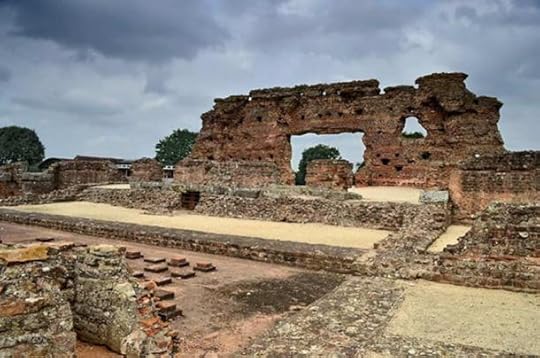 The ruins of Viroconium in central Britain, perhaps the site of the historical Camelot. (Photograph by EarthQuest Photography)Perhaps this was the person who reorganized the British forces to repel the Anglo-Saxons. If this was the Arthur recorded by Nennius, then he was active in many locations. Nennius records twelve of Arthur’s battles, located in various parts of the country, meaning that although he may ultimately have ruled from a city in the center of Britain, Arthur could have been born just about anywhere. So could he have been born at Tintagel?
The ruins of Viroconium in central Britain, perhaps the site of the historical Camelot. (Photograph by EarthQuest Photography)Perhaps this was the person who reorganized the British forces to repel the Anglo-Saxons. If this was the Arthur recorded by Nennius, then he was active in many locations. Nennius records twelve of Arthur’s battles, located in various parts of the country, meaning that although he may ultimately have ruled from a city in the center of Britain, Arthur could have been born just about anywhere. So could he have been born at Tintagel?Fiction from Fact?Although Geoffrey of Monmouth’s account of Arthur’s birth reads like fantasy, it’s possible that it was based on a kernel of truth. The story of Excalibur being thrown to the Lady of the Lake when Arthur lies mortally wounded on the field of battle sounds equally unlikely. Nevertheless, archeology has uncovered many weapons, including swords that had been cast into sacred pools and lakes by the ancient Britons as offerings to a water goddess. Perhaps Arthur’s sword really was thrown into a lake in the hope that such a deity would heal him.
The Bewitching Tale of Morgan le Fay, a Captivating Character of Arthurian Legend The Legend of the Fisher King and Elements of the Divine Fishermen in Ancient Mythology Meet Magnus Maximus, the Roman Usurper-Turned-Welsh Hero Who Inspired King Arthur A similar embellishment may account for the story of Arthur’s conception. Royal advisors, such as Merlin is said to have been, did exist during the fifth century. They were known as bards: part poets, part shamans who were accredited with knowledge of medicinal plants. These included hallucinogens such as the famous “magic mushroom.” Perhaps it was Igraine who was given a potion to make her believe that Uther was her husband. Yet even if the legend of Arthur’s conception was based loosely on some kind of genuine event, the location of Arthur’s supposed conception has long been in question.
 Illustration: Merlin taking away the infant Arthur - "So the child was delivered unto Merlin, and so he bore it forth."(
Public Domain
)Although works such as that by Nennius do suggest that there was an historical figure behind the legend of King Arthur, Geoffrey has Arthur’s nativity occurring in a castle that stood in Tintagel during his day; A structure that historical records reveal was only built in the early twelfth century, 600 years too late to have been the birthplace of a king who was said to have lived around AD 500.
Illustration: Merlin taking away the infant Arthur - "So the child was delivered unto Merlin, and so he bore it forth."(
Public Domain
)Although works such as that by Nennius do suggest that there was an historical figure behind the legend of King Arthur, Geoffrey has Arthur’s nativity occurring in a castle that stood in Tintagel during his day; A structure that historical records reveal was only built in the early twelfth century, 600 years too late to have been the birthplace of a king who was said to have lived around AD 500. The remains of Tintagel Castle in Cornwall, the legendary place of King Arthur’s birth. (Photograph by EarthQuest Photography)The craggy, grey stone ruins that can be seen on the cliffs of Tintagel today are the remains of a castle built in the thirteenth century, replacing the one that stood there in Geoffrey’s time. But even this structure had not been erected until the early 1100s. However, the archaeological excavations being conducted at present are unearthing what appear to have been the foundations of a much older building that previously occupied the site. Judging by the high-status artifacts so far unearthed, such as exquisite pottery, ceramics, and glass, it is thought to have been the residence of a wealthy and important individual who lived at the very time Arthur is said to have lived—perhaps the historical Arthur’s mother. The fabled king could indeed—just possibly—have been born at Tintagel after all. If this is where Arthur had his origins, then perhaps the excavations, still ongoing, might finally uncover something bearing his name: the ultimate proof that King Arthur really did exist.
The remains of Tintagel Castle in Cornwall, the legendary place of King Arthur’s birth. (Photograph by EarthQuest Photography)The craggy, grey stone ruins that can be seen on the cliffs of Tintagel today are the remains of a castle built in the thirteenth century, replacing the one that stood there in Geoffrey’s time. But even this structure had not been erected until the early 1100s. However, the archaeological excavations being conducted at present are unearthing what appear to have been the foundations of a much older building that previously occupied the site. Judging by the high-status artifacts so far unearthed, such as exquisite pottery, ceramics, and glass, it is thought to have been the residence of a wealthy and important individual who lived at the very time Arthur is said to have lived—perhaps the historical Arthur’s mother. The fabled king could indeed—just possibly—have been born at Tintagel after all. If this is where Arthur had his origins, then perhaps the excavations, still ongoing, might finally uncover something bearing his name: the ultimate proof that King Arthur really did exist.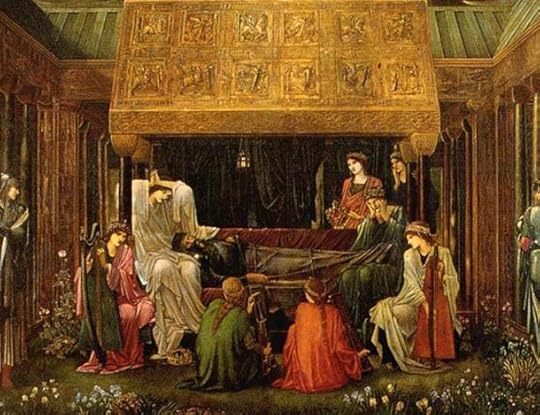 The Last Sleep of Arthur in Avalon. (
Public Domain
)Graham Phillips is author of
The Lost Tomb of King Arthur
, published by Inner Traditions.
The Last Sleep of Arthur in Avalon. (
Public Domain
)Graham Phillips is author of
The Lost Tomb of King Arthur
, published by Inner Traditions.--
Top Image: King Arthur. Detail. Charles Ernest Butler, 1903. ( Public Domain )
By Graham Phillips
ReferencesJason Daley, August 5 2016. “Archaeologists at Tintagel uncover walls and artifacts from a Dark Ages complex likely used by local kings.” Smithsonianmag.com [Online] Available at: http://www.smithsonianmag.com/smart-news/palace-unearthed-king-arthurs-birthplace-180960035/?no-ist
Published on August 17, 2016 03:00
August 16, 2016
How the Vikings Started the Worldwide Distribution of Gaited Horses
Ancient Origins

Some horses have special gaits, which are more comfortable for the rider than walk, trot or gallop. Now, a study by an international research team under the direction of the Leibniz Institute for Zoo and Wildlife Research (IZW) in Berlin revealed that these gaited horses most likely originated in the 9th century medieval England. From there they were brought to Iceland by the Vikings and later spread all over Europe and Asia. These findings were published in the current issue of the journal "Current Biology."
Walk, trot and gallop are the gaits which all horses can master. However, riders who want to sit in their saddle more comfortably while still making good time on long journeys would benefit from choosing gaited horses. They are able to perform special gaits, like the ambling or pacing, which are typical for Icelandic horses and allow for a smoother ride. Responsible for this ability is a mutation in the DMRT3 gene, which was recently shown by a study with over 4,000 horses from different breeds. To investigate the history of gaited horses the scientist analysed this mutation in the genome of 90 horses from the Copper Age (6000 BC) to the Middle Ages (11th century). They detected the mutation in samples of two English horses from 850 -- 900 AD and more frequently in Icelandic horses dating to the 9th -- 11th century. Most likely the first gaited horses appeared in medieval England and were then transported to Iceland by the Vikings. Horses have existed in Iceland since 870 BC. In contrast, no European (Scandinavia included) or Asian horse of the same period carrying the mutation for the alternative gaits was found.
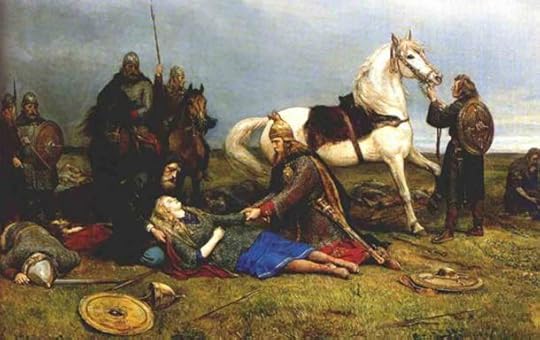 Vikings with their horses. A painting by Peter Nicolai Arbo (
public domain
)It is improbable that the English and Icelandic gaited horse populations developed independently from each other in such a short time. "It is much more likely, that the first horses ever imported to Iceland already carried the mutation for alternative gaits. The Vikings recognised the value of the gaited horses and preferentially selected for this trait -- thereby laying the foundation for the worldwide distribution," explains Arne Ludwig, geneticist at the IZW. Historic sagas also suggest that Icelandic horses exhibited the ability for alternative gaits at a very early stage. Although the origin of the Icelandic horse is not fully resolved, the general assumption is that they came to the island together with the Vikings. However, since the mutation was not found in Scandinavian horses of the 9th century, horses from other regions must have been brought to Iceland as well.
Vikings with their horses. A painting by Peter Nicolai Arbo (
public domain
)It is improbable that the English and Icelandic gaited horse populations developed independently from each other in such a short time. "It is much more likely, that the first horses ever imported to Iceland already carried the mutation for alternative gaits. The Vikings recognised the value of the gaited horses and preferentially selected for this trait -- thereby laying the foundation for the worldwide distribution," explains Arne Ludwig, geneticist at the IZW. Historic sagas also suggest that Icelandic horses exhibited the ability for alternative gaits at a very early stage. Although the origin of the Icelandic horse is not fully resolved, the general assumption is that they came to the island together with the Vikings. However, since the mutation was not found in Scandinavian horses of the 9th century, horses from other regions must have been brought to Iceland as well.
 An Icelandic gaited horse (
public domain
)Historic records report that Vikings were repeatedly pillaging on the British Isles and conquered the region of today's Yorkshire -- precisely the region the two historic gaited horses originated from. "Taking that into account our results suggest that Vikings first encountered gaited horses on the British Isles and transported them to Iceland," explains Saskia Wutke, PhD student at the IZW and first lead author of the study. The high frequency of the mutation for gaitedness in the early Icelandic horses indicates that the Icelandic settlers preferably bred gaited horses -- apparently the comfortable gaits proved to be particularly suitable for long distance travel through rough terrain.
An Icelandic gaited horse (
public domain
)Historic records report that Vikings were repeatedly pillaging on the British Isles and conquered the region of today's Yorkshire -- precisely the region the two historic gaited horses originated from. "Taking that into account our results suggest that Vikings first encountered gaited horses on the British Isles and transported them to Iceland," explains Saskia Wutke, PhD student at the IZW and first lead author of the study. The high frequency of the mutation for gaitedness in the early Icelandic horses indicates that the Icelandic settlers preferably bred gaited horses -- apparently the comfortable gaits proved to be particularly suitable for long distance travel through rough terrain.
DiscoverLeibniz AssociationSaddleGenomeMutation
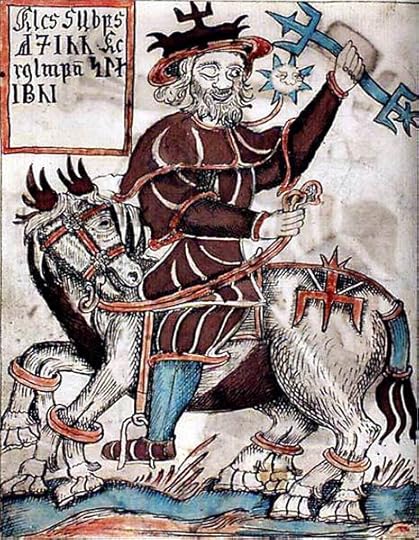 An illustration of Odin riding Sleipnir, the eight-legged horse from an 18th-century Icelandic manuscript. (
public domain
)Top image: A scene of a Viking on a horse from New Witcher 3: Wild Hunt
An illustration of Odin riding Sleipnir, the eight-legged horse from an 18th-century Icelandic manuscript. (
public domain
)Top image: A scene of a Viking on a horse from New Witcher 3: Wild Hunt
Source: Forschungsverbund Berlin e.V. (FVB). "How the Vikings started the worldwide distribution of gaited horses." ScienceDaily. ScienceDaily, 8 August 2016. www.sciencedaily.com/releases/2016/08/160808123849.htm

Some horses have special gaits, which are more comfortable for the rider than walk, trot or gallop. Now, a study by an international research team under the direction of the Leibniz Institute for Zoo and Wildlife Research (IZW) in Berlin revealed that these gaited horses most likely originated in the 9th century medieval England. From there they were brought to Iceland by the Vikings and later spread all over Europe and Asia. These findings were published in the current issue of the journal "Current Biology."
Walk, trot and gallop are the gaits which all horses can master. However, riders who want to sit in their saddle more comfortably while still making good time on long journeys would benefit from choosing gaited horses. They are able to perform special gaits, like the ambling or pacing, which are typical for Icelandic horses and allow for a smoother ride. Responsible for this ability is a mutation in the DMRT3 gene, which was recently shown by a study with over 4,000 horses from different breeds. To investigate the history of gaited horses the scientist analysed this mutation in the genome of 90 horses from the Copper Age (6000 BC) to the Middle Ages (11th century). They detected the mutation in samples of two English horses from 850 -- 900 AD and more frequently in Icelandic horses dating to the 9th -- 11th century. Most likely the first gaited horses appeared in medieval England and were then transported to Iceland by the Vikings. Horses have existed in Iceland since 870 BC. In contrast, no European (Scandinavia included) or Asian horse of the same period carrying the mutation for the alternative gaits was found.
 Vikings with their horses. A painting by Peter Nicolai Arbo (
public domain
)It is improbable that the English and Icelandic gaited horse populations developed independently from each other in such a short time. "It is much more likely, that the first horses ever imported to Iceland already carried the mutation for alternative gaits. The Vikings recognised the value of the gaited horses and preferentially selected for this trait -- thereby laying the foundation for the worldwide distribution," explains Arne Ludwig, geneticist at the IZW. Historic sagas also suggest that Icelandic horses exhibited the ability for alternative gaits at a very early stage. Although the origin of the Icelandic horse is not fully resolved, the general assumption is that they came to the island together with the Vikings. However, since the mutation was not found in Scandinavian horses of the 9th century, horses from other regions must have been brought to Iceland as well.
Vikings with their horses. A painting by Peter Nicolai Arbo (
public domain
)It is improbable that the English and Icelandic gaited horse populations developed independently from each other in such a short time. "It is much more likely, that the first horses ever imported to Iceland already carried the mutation for alternative gaits. The Vikings recognised the value of the gaited horses and preferentially selected for this trait -- thereby laying the foundation for the worldwide distribution," explains Arne Ludwig, geneticist at the IZW. Historic sagas also suggest that Icelandic horses exhibited the ability for alternative gaits at a very early stage. Although the origin of the Icelandic horse is not fully resolved, the general assumption is that they came to the island together with the Vikings. However, since the mutation was not found in Scandinavian horses of the 9th century, horses from other regions must have been brought to Iceland as well. An Icelandic gaited horse (
public domain
)Historic records report that Vikings were repeatedly pillaging on the British Isles and conquered the region of today's Yorkshire -- precisely the region the two historic gaited horses originated from. "Taking that into account our results suggest that Vikings first encountered gaited horses on the British Isles and transported them to Iceland," explains Saskia Wutke, PhD student at the IZW and first lead author of the study. The high frequency of the mutation for gaitedness in the early Icelandic horses indicates that the Icelandic settlers preferably bred gaited horses -- apparently the comfortable gaits proved to be particularly suitable for long distance travel through rough terrain.
An Icelandic gaited horse (
public domain
)Historic records report that Vikings were repeatedly pillaging on the British Isles and conquered the region of today's Yorkshire -- precisely the region the two historic gaited horses originated from. "Taking that into account our results suggest that Vikings first encountered gaited horses on the British Isles and transported them to Iceland," explains Saskia Wutke, PhD student at the IZW and first lead author of the study. The high frequency of the mutation for gaitedness in the early Icelandic horses indicates that the Icelandic settlers preferably bred gaited horses -- apparently the comfortable gaits proved to be particularly suitable for long distance travel through rough terrain.DiscoverLeibniz AssociationSaddleGenomeMutation
 An illustration of Odin riding Sleipnir, the eight-legged horse from an 18th-century Icelandic manuscript. (
public domain
)Top image: A scene of a Viking on a horse from New Witcher 3: Wild Hunt
An illustration of Odin riding Sleipnir, the eight-legged horse from an 18th-century Icelandic manuscript. (
public domain
)Top image: A scene of a Viking on a horse from New Witcher 3: Wild HuntSource: Forschungsverbund Berlin e.V. (FVB). "How the Vikings started the worldwide distribution of gaited horses." ScienceDaily. ScienceDaily, 8 August 2016. www.sciencedaily.com/releases/2016/08/160808123849.htm
Published on August 16, 2016 03:00
August 15, 2016
Tutankhamun: who’s afraid of the pharaoh’s curse?
History Extra
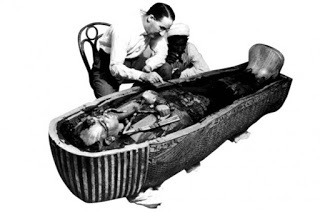 Carter examines the nest of coffins shortly after the discovery. He was to spend the next decade documenting the finds. (Griffith Institute/Illustrated London News)
Carter examines the nest of coffins shortly after the discovery. He was to spend the next decade documenting the finds. (Griffith Institute/Illustrated London News)
On 26 November 1922 Howard Carter stood before a sealed door blocking a dark corridor. Behind him stood his patron Lord Carnarvon. Both men knew that they were standing in the tomb of the 18th-Dynasty boy king Tutankhamun – the sealing on the now dismantled outer door had made that clear. But the outer door had also shown the unmistakable signs of more than one forced entry. Was Tutankhamun still lying undisturbed in his tomb? Or had the ancient robbers once again thwarted the modern archaeologists? Nervously, his hands trembling, Carter forced a small hole in the left hand corner of the doorway, lit a candle, and peered inside.
“Presently, as my eyes grew accustomed to the light, details of the room within emerged slowly from the mist, strange animals, statues and gold – everywhere the glint of gold. For the moment – an eternity it must have seemed to the others standing by – I was struck dumb with amazement, and when Lord Carnarvon, unable to stand the suspense any longer, inquired anxiously, ‘Can you see anything?’ it was all I could do to get out the words ‘Yes, wonderful things’.”
The next day the doorway was unblocked and an electric light installed. Carter and Carnarvon found themselves standing in the antechamber, an untidy room packed with everything that an Egyptian king could possibly need for an enjoyable afterlife. But Carter’s attention was fixed on the northern wall. Here, blocked, plastered, sealed and guarded by two large statues of Tutankhamun, was the doorway to the burial chamber. Once again, the sealed doorway had been breached by a robber’s hole.
Carter and Carnarvon knew that the anteroom must be emptied before the wall could be dismantled, but that would take many weeks of hard work. Desperate to know if the tomb was intact they returned that night and crawled through the robber’s hole. To their delight they found that the burial chamber was almost completely filled by a golden shrine, its seals still intact. Swearing each other to secrecy they crawled back and sealed the hole.
The burial chamber would be officially opened on 17 February 1923 in the presence of an invited audience of Egyptologists and government officials.
The public was fascinated by the activities in the Valley of the Kings. Those who could travel to Egypt did, though there was little for them to see. Those who could not visit in person relied upon the newspapers that carried almost daily reports from the Valley. Soon the small, sleepy town of Luxor was swamped with visitors and the expedition found itself living in near siege conditions. As a means of recovering some of the money that he had spent looking for Tutankhamun, Carnarvon decided to sign an exclusive deal with The Times. This incensed the reporters from the other newspapers, and did nothing to stop their demands for information. Denied official access to the tomb, they now printed sensational gossip in place of facts.
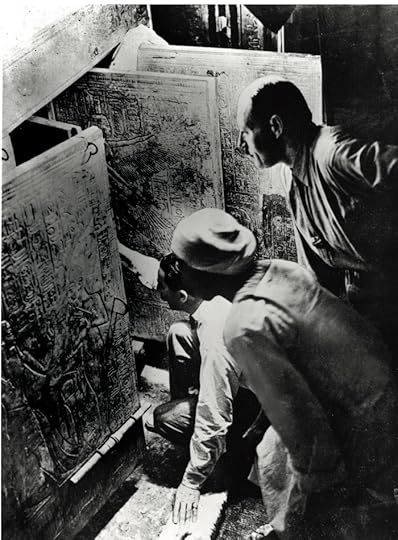
Carter, watched by assistant Arthur Callender and an Egyptian foreman, opens the golden shrines surrounding the sarcophagus. (Hulton Archive/Getty Images)
In late February 1923 the excavation was closed to allow the exhausted excavators a brief holiday. While Carter stayed in Luxor, Carnarvon and his daughter, Lady Evelyn Herbert, sailed south to spend a few days at Aswan. During this trip Carnarvon was bitten on the cheek by a mosquito. Then, soon after his return to Luxor, he accidentally sliced the scab off the bite while shaving. He soon started to feel unwell. With his condition worsening he travelled to Cairo for expert medical attention. But it was too late. Blood poisoning set in and pneumonia followed. A younger, fitter man may have been able to throw off the infection, but the 57-year-old Carnarvon was still suffering the effects of a severe motor accident in 1901 that had left him weak and vulnerable to chest infections. He died on 5 April 1923.
Here was a dramatic Tutankhamun story that everyone could report. News of the death travelled fast, stimulating intense debate. For the first time the general public, made sensitive to the plight of the defenceless dead by the First World War and the major flu epidemic that followed it, started to question the archaeologists’ easy assumption that the dead were a legitimate target. Would Carter be happy if someone attempted to dig up the recently deceased Queen Victoria, asked one indignant Times correspondent?
For some observers this was far more than a question of ethics. They believed that the excavation had put the lives of the archaeologists at risk. Anyone with a taste for popular fiction understood just how dangerous the ancient Egyptians could be. Victorian literature was filled with accounts of vengeful mummies who strangled, poisoned and possessed their victims, with one of the most sensational works, Lost in a Pyramid, or, The Mummy’s Curse, being penned by Louisa May Alcott, more famous today as the author of Little Women. Already, before Carnarvon’s death, novelist Marie Corelli had warned against tampering with the unknown: “I cannot but think that some risks are run by breaking into the last rest of a king of Egypt whose tomb is specifically and solemnly guarded, and robbing him of his possessions”.
Britain, in 1923, was a land looking for comfort. The old religious certainties, already weakened by the scientific advances of the Victorian age, had been further eroded by the horrors of the First World War. Now the country was experiencing a wave of interest in all aspects of the occult as seances and ouija boards offered a glimmer of hope that the bereaved could contact those who had “passed over”. Theosophy, an occult attempt to reach spiritual enlightenment partially inspired by the spiritual forces or “elementals” of the ancient Egyptians, was all the rage.
False reports started to emerge from the tomb. Many people believed that an engraved plaque – “Death comes on swift wings to he who disturbs the tomb of the pharaoh” – had been discovered and suppressed by Carter. It hadn’t; the plaque quite simply did not exist. Carter himself had little patience with the curse theorists. He made his feelings plain in an interview with the New York Times: “It is rather too much to ask me to believe that some spook is keeping watch and ward over the dead Pharaoh, ready to wreak vengeance on anyone who goes too near”. Inevitably, his vehement denial sparked rumours that Carter was collaborating with “the authorities” to hide the evidence of a dangerous curse.
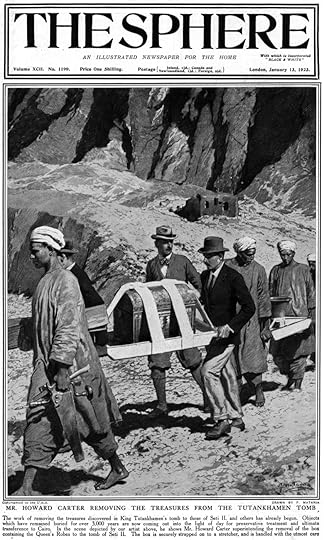
Reporting the discovery, 13 January 1923. (Illustrated London News)
Testing the curse theoryHow could the long-dead Tutankhamun have killed anyone? The idea that his burial might have been booby trapped with poison was a popular one. It is theoretically possible that the sealed chamber could have housed a cocktail of microscopic spores and, indeed, a black fungus was found growing inside the tomb. However the Egyptian scientists simply did not have the knowledge necessary to set such a sophisticated trap. Could Carnarvon have been killed accidentally? Maybe he had been infected by poisonous bat-droppings? Or had been poisoned by a mosquito which had drunk embalming fluids?
It was left to the more practically minded to point out that the sealed tomb could not have housed a bat colony, while the lack of water in the Valley of the Kings meant that there were no mosquitoes. This injection of common sense did little to halt speculation. Many “experts”, most notably Sir Arthur Conan Doyle, author of two popular tales of ancient Egypt, preferred the idea of an intangible curse implemented by “elementals”.
In 1934 Egyptologist Herbert Winlock attempted to disprove the curse theory by studying the statistics. He found that only six of the 26 people present at the opening of the tomb had died within a decade. Time was to prove that, of those who had first visited the burial chamber, only Carnarvon had died suddenly at the relatively young age of 57. Howard Carter died aged 64, some 16 years after Carnarvon, while Lady Evelyn, who had been present on the first, clandestine, visit to the burial chamber, did not die until 1980.
Professor Douglas Derry who, it might be argued, committed the gravest desecration by autopsying and dismembering the king’s body, reached the grand age of 87. In 2002 Mark Nelson of Monash University, Melbourne, confirmed Winlock’s results, finding that the 25 people most likely to have been exposed to the curse died at an average age of 70. To set these figures into context, life expectancy at birth for men born in 1900 was 47 years, while those who lived to the age of 65 might be expected to reach the age of 76.
------------------------------------------Howard Carter: the accidental egyptologistHoward Carter was a gifted artist who became an Egyptologist by accident. Born on 9 May 1874, the youngest of the seven surviving children of the animal painter Samuel Carter and his wife Martha, he was raised in the Norfolk village of Swaffham, where he came under the patronage of the Amhersts of Didlington Hall. William Amherst Tyssen-Amherst was a keen amateur Egyptologist with a private museum. It was on his recommendation that the Egypt Exploration Fund employed the 17 year-old Carter as a draughtsman.
Carter gained valuable experience working on the rock tombs of Beni Hassan, at the desert city of Amarna, and at Hatshepsut’s Deir el-Bahari mortuary temple. Then, in 1899, he was offered a permanent position with the Egyptian Antiquities Service. He spent five productive years in Luxor as antiquities inspector for Southern Egypt before moving to Cairo to become inspector for Northern Egypt. Here his career received an unexpected check. An argument with a group of drunken Frenchmen led to his resignation from the antiquities service, and in October 1905 he started a new life as an artist and antiquities dealer.
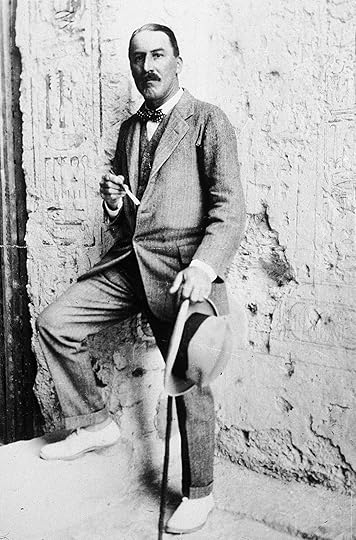
Howard Carter, Egypt, 1923. (Photo by Hulton Archive/Getty Images)
Carter lived a hand to mouth existence until he was introduced to Lord Carnarvon, a wealthy amateur Egyptologist in need of a professional partner. Together in 1917 they determined to discover the tomb of Tutankhamun. Carter was prepared to strip the Valley of the Kings down to the bedrock if necessary. Carnarvon, who was funding the mission, was at first equally enthusiastic, but by 1922 was having second thoughts. The partners agreed that the 1922–3 season of excavation would be the last. Digging started on 1 November 1922. Just three days later the entrance to Tutankhamun’s tomb was revealed.
His great discovery saw the end of Carter’s career as an excavator. He was to spend the next decade recording and preserving the tomb and its contents. When the tomb was finally empty, the publication of the results became his top priority. But his health was starting to fail and the publication was never completed. Howard Carter died in London on 2 March 1939.
The curse: suspicious deaths or just coincidence?On 6 April 1923 the Daily Express printed a story telling how, at the exact moment
of Carnarvon’s death the previous day, Cairo was plunged into darkness. No explanation could be found for this unexpected power failure although anyone who has visited the Egyptian capital will confirm that power cuts are by no means rare events. Far more intriguing is the story of Carnarvon’s three-legged fox terrier, Susie. Susie had been left behind in England. At exactly the moment of her master’s death, the dog sat up and howled. In later versions of the anecdote Susie actually died. However, it has proved impossible to trace this story to its source.
One violent death attributed to Tutankhamun was that of Professor HG Evelyn-White, classicist and archaeologist at Leeds University, who committed suicide in a taxi in 1924. The newspapers were thrilled to report that the Professor had left a suicide note stating: “I know there is a curse on me”. Another “curse victim” was Richard Bethell, an assistant to Howard Carter, who died of apparently natural causes at the Bath Club in 1929.
After hearing the sad news his father, Lord Westbury, an amateur Egyptologist, threw himself out of a seventh-story window. On the way to the cemetery Lord Westbury’s hearse knocked down and killed an eight-year-old boy. Many people believe that the British Museum owns a cursed coffin lid that has been blamed for a variety of disasters including the sinking of the Titanic. The lid, known to believers as the coffin of the magical priestess of Amen-Re, is an ordinary 21st-Dynasty coffin lid belonging to an unnamed lady.
The significance of the discovery: why tutankhamun’s tomb was so specialTutankhamun is the only New Kingdom (c 1550–1070 BC) monarch to have been discovered undisturbed in his own sarcophagus. Dying at just 20 years of age, before his tomb was complete, he was interred in a small-scale courtier’s tomb with a restricted number of grave goods. His tomb was robbed at least twice in antiquity and Carter estimated that thieves stole more than half of his jewellery.
Nevertheless, his burial has provided Egyptologists with the most substantial and diverse collection of royal artefacts ever recovered. They offer a rare opportunity to understand aspects of New Kingdom life, including crafts and technologies, art styles, clothing and foods, religion and funerary beliefs. Meanwhile the king’s body is the subject of a research project conducted by the Egyptian Antiquities Service under the supervision of Dr Zahi Hawass. If there is one disappointment, it is the almost complete lack of non-ritual written material in the tomb.
His personal history remains a mystery and we cannot name his parents with any degree of certainty.
Writer and broadcaster Dr Joyce Tyldesley is honorary research fellow at the School of Archaeology, Classics and Egyptology at Liverpool University, and teaches Egyptology at Manchester University.
 Carter examines the nest of coffins shortly after the discovery. He was to spend the next decade documenting the finds. (Griffith Institute/Illustrated London News)
Carter examines the nest of coffins shortly after the discovery. He was to spend the next decade documenting the finds. (Griffith Institute/Illustrated London News) On 26 November 1922 Howard Carter stood before a sealed door blocking a dark corridor. Behind him stood his patron Lord Carnarvon. Both men knew that they were standing in the tomb of the 18th-Dynasty boy king Tutankhamun – the sealing on the now dismantled outer door had made that clear. But the outer door had also shown the unmistakable signs of more than one forced entry. Was Tutankhamun still lying undisturbed in his tomb? Or had the ancient robbers once again thwarted the modern archaeologists? Nervously, his hands trembling, Carter forced a small hole in the left hand corner of the doorway, lit a candle, and peered inside.
“Presently, as my eyes grew accustomed to the light, details of the room within emerged slowly from the mist, strange animals, statues and gold – everywhere the glint of gold. For the moment – an eternity it must have seemed to the others standing by – I was struck dumb with amazement, and when Lord Carnarvon, unable to stand the suspense any longer, inquired anxiously, ‘Can you see anything?’ it was all I could do to get out the words ‘Yes, wonderful things’.”
The next day the doorway was unblocked and an electric light installed. Carter and Carnarvon found themselves standing in the antechamber, an untidy room packed with everything that an Egyptian king could possibly need for an enjoyable afterlife. But Carter’s attention was fixed on the northern wall. Here, blocked, plastered, sealed and guarded by two large statues of Tutankhamun, was the doorway to the burial chamber. Once again, the sealed doorway had been breached by a robber’s hole.
Carter and Carnarvon knew that the anteroom must be emptied before the wall could be dismantled, but that would take many weeks of hard work. Desperate to know if the tomb was intact they returned that night and crawled through the robber’s hole. To their delight they found that the burial chamber was almost completely filled by a golden shrine, its seals still intact. Swearing each other to secrecy they crawled back and sealed the hole.
The burial chamber would be officially opened on 17 February 1923 in the presence of an invited audience of Egyptologists and government officials.
The public was fascinated by the activities in the Valley of the Kings. Those who could travel to Egypt did, though there was little for them to see. Those who could not visit in person relied upon the newspapers that carried almost daily reports from the Valley. Soon the small, sleepy town of Luxor was swamped with visitors and the expedition found itself living in near siege conditions. As a means of recovering some of the money that he had spent looking for Tutankhamun, Carnarvon decided to sign an exclusive deal with The Times. This incensed the reporters from the other newspapers, and did nothing to stop their demands for information. Denied official access to the tomb, they now printed sensational gossip in place of facts.

Carter, watched by assistant Arthur Callender and an Egyptian foreman, opens the golden shrines surrounding the sarcophagus. (Hulton Archive/Getty Images)
In late February 1923 the excavation was closed to allow the exhausted excavators a brief holiday. While Carter stayed in Luxor, Carnarvon and his daughter, Lady Evelyn Herbert, sailed south to spend a few days at Aswan. During this trip Carnarvon was bitten on the cheek by a mosquito. Then, soon after his return to Luxor, he accidentally sliced the scab off the bite while shaving. He soon started to feel unwell. With his condition worsening he travelled to Cairo for expert medical attention. But it was too late. Blood poisoning set in and pneumonia followed. A younger, fitter man may have been able to throw off the infection, but the 57-year-old Carnarvon was still suffering the effects of a severe motor accident in 1901 that had left him weak and vulnerable to chest infections. He died on 5 April 1923.
Here was a dramatic Tutankhamun story that everyone could report. News of the death travelled fast, stimulating intense debate. For the first time the general public, made sensitive to the plight of the defenceless dead by the First World War and the major flu epidemic that followed it, started to question the archaeologists’ easy assumption that the dead were a legitimate target. Would Carter be happy if someone attempted to dig up the recently deceased Queen Victoria, asked one indignant Times correspondent?
For some observers this was far more than a question of ethics. They believed that the excavation had put the lives of the archaeologists at risk. Anyone with a taste for popular fiction understood just how dangerous the ancient Egyptians could be. Victorian literature was filled with accounts of vengeful mummies who strangled, poisoned and possessed their victims, with one of the most sensational works, Lost in a Pyramid, or, The Mummy’s Curse, being penned by Louisa May Alcott, more famous today as the author of Little Women. Already, before Carnarvon’s death, novelist Marie Corelli had warned against tampering with the unknown: “I cannot but think that some risks are run by breaking into the last rest of a king of Egypt whose tomb is specifically and solemnly guarded, and robbing him of his possessions”.
Britain, in 1923, was a land looking for comfort. The old religious certainties, already weakened by the scientific advances of the Victorian age, had been further eroded by the horrors of the First World War. Now the country was experiencing a wave of interest in all aspects of the occult as seances and ouija boards offered a glimmer of hope that the bereaved could contact those who had “passed over”. Theosophy, an occult attempt to reach spiritual enlightenment partially inspired by the spiritual forces or “elementals” of the ancient Egyptians, was all the rage.
False reports started to emerge from the tomb. Many people believed that an engraved plaque – “Death comes on swift wings to he who disturbs the tomb of the pharaoh” – had been discovered and suppressed by Carter. It hadn’t; the plaque quite simply did not exist. Carter himself had little patience with the curse theorists. He made his feelings plain in an interview with the New York Times: “It is rather too much to ask me to believe that some spook is keeping watch and ward over the dead Pharaoh, ready to wreak vengeance on anyone who goes too near”. Inevitably, his vehement denial sparked rumours that Carter was collaborating with “the authorities” to hide the evidence of a dangerous curse.

Reporting the discovery, 13 January 1923. (Illustrated London News)
Testing the curse theoryHow could the long-dead Tutankhamun have killed anyone? The idea that his burial might have been booby trapped with poison was a popular one. It is theoretically possible that the sealed chamber could have housed a cocktail of microscopic spores and, indeed, a black fungus was found growing inside the tomb. However the Egyptian scientists simply did not have the knowledge necessary to set such a sophisticated trap. Could Carnarvon have been killed accidentally? Maybe he had been infected by poisonous bat-droppings? Or had been poisoned by a mosquito which had drunk embalming fluids?
It was left to the more practically minded to point out that the sealed tomb could not have housed a bat colony, while the lack of water in the Valley of the Kings meant that there were no mosquitoes. This injection of common sense did little to halt speculation. Many “experts”, most notably Sir Arthur Conan Doyle, author of two popular tales of ancient Egypt, preferred the idea of an intangible curse implemented by “elementals”.
In 1934 Egyptologist Herbert Winlock attempted to disprove the curse theory by studying the statistics. He found that only six of the 26 people present at the opening of the tomb had died within a decade. Time was to prove that, of those who had first visited the burial chamber, only Carnarvon had died suddenly at the relatively young age of 57. Howard Carter died aged 64, some 16 years after Carnarvon, while Lady Evelyn, who had been present on the first, clandestine, visit to the burial chamber, did not die until 1980.
Professor Douglas Derry who, it might be argued, committed the gravest desecration by autopsying and dismembering the king’s body, reached the grand age of 87. In 2002 Mark Nelson of Monash University, Melbourne, confirmed Winlock’s results, finding that the 25 people most likely to have been exposed to the curse died at an average age of 70. To set these figures into context, life expectancy at birth for men born in 1900 was 47 years, while those who lived to the age of 65 might be expected to reach the age of 76.
------------------------------------------Howard Carter: the accidental egyptologistHoward Carter was a gifted artist who became an Egyptologist by accident. Born on 9 May 1874, the youngest of the seven surviving children of the animal painter Samuel Carter and his wife Martha, he was raised in the Norfolk village of Swaffham, where he came under the patronage of the Amhersts of Didlington Hall. William Amherst Tyssen-Amherst was a keen amateur Egyptologist with a private museum. It was on his recommendation that the Egypt Exploration Fund employed the 17 year-old Carter as a draughtsman.
Carter gained valuable experience working on the rock tombs of Beni Hassan, at the desert city of Amarna, and at Hatshepsut’s Deir el-Bahari mortuary temple. Then, in 1899, he was offered a permanent position with the Egyptian Antiquities Service. He spent five productive years in Luxor as antiquities inspector for Southern Egypt before moving to Cairo to become inspector for Northern Egypt. Here his career received an unexpected check. An argument with a group of drunken Frenchmen led to his resignation from the antiquities service, and in October 1905 he started a new life as an artist and antiquities dealer.

Howard Carter, Egypt, 1923. (Photo by Hulton Archive/Getty Images)
Carter lived a hand to mouth existence until he was introduced to Lord Carnarvon, a wealthy amateur Egyptologist in need of a professional partner. Together in 1917 they determined to discover the tomb of Tutankhamun. Carter was prepared to strip the Valley of the Kings down to the bedrock if necessary. Carnarvon, who was funding the mission, was at first equally enthusiastic, but by 1922 was having second thoughts. The partners agreed that the 1922–3 season of excavation would be the last. Digging started on 1 November 1922. Just three days later the entrance to Tutankhamun’s tomb was revealed.
His great discovery saw the end of Carter’s career as an excavator. He was to spend the next decade recording and preserving the tomb and its contents. When the tomb was finally empty, the publication of the results became his top priority. But his health was starting to fail and the publication was never completed. Howard Carter died in London on 2 March 1939.
The curse: suspicious deaths or just coincidence?On 6 April 1923 the Daily Express printed a story telling how, at the exact moment
of Carnarvon’s death the previous day, Cairo was plunged into darkness. No explanation could be found for this unexpected power failure although anyone who has visited the Egyptian capital will confirm that power cuts are by no means rare events. Far more intriguing is the story of Carnarvon’s three-legged fox terrier, Susie. Susie had been left behind in England. At exactly the moment of her master’s death, the dog sat up and howled. In later versions of the anecdote Susie actually died. However, it has proved impossible to trace this story to its source.
One violent death attributed to Tutankhamun was that of Professor HG Evelyn-White, classicist and archaeologist at Leeds University, who committed suicide in a taxi in 1924. The newspapers were thrilled to report that the Professor had left a suicide note stating: “I know there is a curse on me”. Another “curse victim” was Richard Bethell, an assistant to Howard Carter, who died of apparently natural causes at the Bath Club in 1929.
After hearing the sad news his father, Lord Westbury, an amateur Egyptologist, threw himself out of a seventh-story window. On the way to the cemetery Lord Westbury’s hearse knocked down and killed an eight-year-old boy. Many people believe that the British Museum owns a cursed coffin lid that has been blamed for a variety of disasters including the sinking of the Titanic. The lid, known to believers as the coffin of the magical priestess of Amen-Re, is an ordinary 21st-Dynasty coffin lid belonging to an unnamed lady.
The significance of the discovery: why tutankhamun’s tomb was so specialTutankhamun is the only New Kingdom (c 1550–1070 BC) monarch to have been discovered undisturbed in his own sarcophagus. Dying at just 20 years of age, before his tomb was complete, he was interred in a small-scale courtier’s tomb with a restricted number of grave goods. His tomb was robbed at least twice in antiquity and Carter estimated that thieves stole more than half of his jewellery.
Nevertheless, his burial has provided Egyptologists with the most substantial and diverse collection of royal artefacts ever recovered. They offer a rare opportunity to understand aspects of New Kingdom life, including crafts and technologies, art styles, clothing and foods, religion and funerary beliefs. Meanwhile the king’s body is the subject of a research project conducted by the Egyptian Antiquities Service under the supervision of Dr Zahi Hawass. If there is one disappointment, it is the almost complete lack of non-ritual written material in the tomb.
His personal history remains a mystery and we cannot name his parents with any degree of certainty.
Writer and broadcaster Dr Joyce Tyldesley is honorary research fellow at the School of Archaeology, Classics and Egyptology at Liverpool University, and teaches Egyptology at Manchester University.
Published on August 15, 2016 03:00
August 14, 2016
What was life like for a medieval housewife?
History Extra
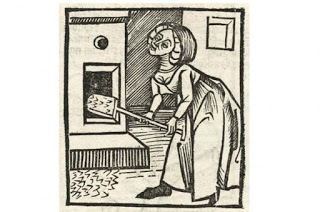 Woodcut of a woman stoking a furnace or baking bread, 1497. (Photo by SSPL/Getty Images)
Woodcut of a woman stoking a furnace or baking bread, 1497. (Photo by SSPL/Getty Images)
Here, writing for History Extra, Toni Mount, author of The Medieval Housewife and Other Women of the Middle Ages, reveals what life was like for a typical housewife in the Middle Ages.
“A woman’s work is never done!” as my mother used to say in the 1960s, when she cared for our family of five and assorted pets, while working as a school dinner lady. Yet this claim was expressed centuries earlier when the Tudor writer and poet Thomas Tusser wrote in his A Hundreth Good Pointes of Husbandrie in 1557:
Some respite to husbands the weather may send,
But housewives’ affairs have never an end.
We can only imagine the drudgery of struggling to do the washing, cooking and cleaning when every task had to be done from scratch – before the linen could be washed, the housewife had to make the lye (the medieval equivalent of detergent) to soak it in, and before dinner could be cooked, the fire had to be lit. The medieval housewife also had to churn butter, brew ale and tend livestock, as well as spin and weave cloth to make clothes for the family.
These tasks had been carried out by housewives for centuries, but how do we know this, and what evidence do we have? Archaeologists have unearthed quern stones for milling grain at home, and found household utensils to give us a few clues. But many medieval women couldn’t read or write, so they never kept diaries or journals telling us about their everyday lives – they would probably have been too busy to find the time for writing, even if they were able.
In the late 14th century, a grey-haired Frenchman, Guy de Montigny, known as ‘the Goodman of Paris’, wrote a detailed instruction book for his young bride [believed to have been around the age of 15] describing her future duties as a housewife. The couple was of the merchant class and, obviously, the girl must have been literate, as she could read his book.
We may shudder at the idea, but an elderly man marrying a teenager was thought to be beneficial to both parties: he got a new lease of life, and she enjoyed the fruits of his successful career and wisdom. Also, a young woman’s first marriage was normally arranged for her – her husband chosen by the family. However, in certain circumstances a widow might be able to choose her second husband. Guy de Montigny admits this, declaring that, if his wife is well trained in her duties, when she marries again after his death she will be a credit to his teaching. This is how he expects her to care for him:
Wherefore love your husband’s person carefully, and I pray you keep him in clean linen, for ‘tis your business... he is upheld by the hope that he hath of the care which his wife will take of him on his return [home]... to be unshod before a good fire, to have his feet washed and fresh shoes and hose, to be given good food and drink, to be well served and well looked after, well bedded in white sheets and nightcaps, well covered with good furs, and assuaged with other joys and desports, privities, loves and secrets whereof I am silent. And the next day fresh shirts and garments. Certes, such services make a man love and desire to return home and to see his goodwife, and to be distant with others.
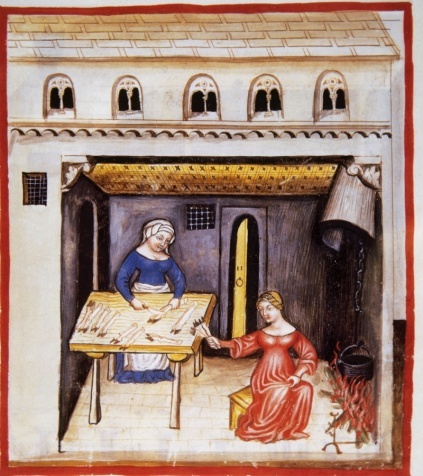
Women cutting pig's trotters. From Tacuinum Sanitatis, a medieval handbook of health (14th century). Miniature. Fol. 78 r. (Photo by: Prisma/UIG via Getty Images)
According to William Langland, who wrote Piers Plowman in the 14th century, there are three things that can drive a man from his home, possibly into another woman’s arms – a leaking roof, a smoking fire and, worst of all, “a shrewish wife who will not be chastised; her mate flees for fear of her tongue...”
On the subject of how a housewife ought to behave, an anonymous verse, known as How the Good Wif taughte hir Doughtir, has down-to-earth instructions for young women, to help them to capture better husbands by behaving suitably:
When you sit in the church, your prayers you shall offer.
Make you no chattering to friend or relation.
Laugh you to scorn neither old folk nor young,
But be of fair bearing and of good tongue...
Go you not into town as if you were a flighty person
From one house to another in search of vain amusement;
And go not to market your burrel [cheap, home-spun cloth] to sell,
And then to the tavern to destroy your reputation...
Go not to wrestlings, nor to shooting at cock,
As if you were a strumpet or a wanton woman.
Stay at home daughter, and love your work much,
And so you shall, my dear child, soon grow rich.
For a rough guide to what life was like for a housewife of the lower class, we can refer to an intriguing 15th-century poem, based on a much earlier text, called the Ballad of a Tyrannical Husband, which gives us some idea of how a poor woman’s work was certainly never done:
The goodman [husband] and his lad to the plough are gone,
The goodwife had much to do, and servant had she none,
Many small children to look after beside herself alone,
She did more than she could inside her own house.
Home came the goodman early in the day
To see that everything was according to his wishes.
“Dame,” he said, “is our dinner ready?” “Sir,” she said, “nay.
How would you have me do more than I can?”
Then he began to chide and said, “Damn thee!
I wish you would go all day to plough with me,
To walk in the clods that are wet and boggy,
Then you would know what a ploughman be.”
Then the goodwife swore, and thus she say,
“I have more to do than ever I may.
If you were to follow me for a day,
You would be weary of your part, I bet my head on it.”
“Weary! In the devil’s name!” said the goodman,
“What have you to do, but sit here at home?
You go to your neighbour’s house, one after the other,
And sit there chattering with Jack and with John.”
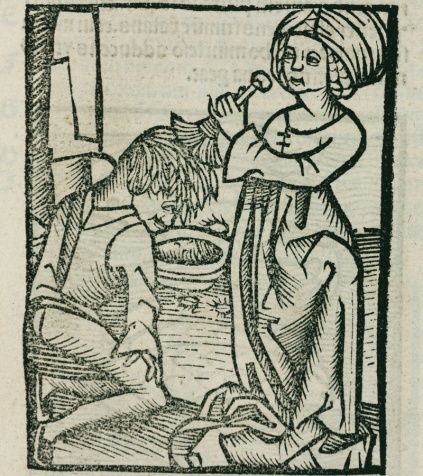
Woodcut showing a man being de-loused; three lice can be seen around the bowl. Illustration from Hortus Sanitatis (Garden of Health), printed by Johann Pruss in Strasbourg in 1497. (Photo by SSPL/Getty Images)
The goodwife then tells him how she had hardly any sleep last night because of the baby, yet she was first up in the morning to milk the cows and take them out to pasture while he was still asleep. Then she spends the day making butter and cheese and tending the children. She has to feed the chickens, ducks and geese, and take them onto the green. She bakes and brews and prepares flax for weaving. She teases, cards and spins wool.
Her husband then complains that she brews and bakes more often than necessary – once a fortnight would be enough. She laughs. She goes on to explain how she makes the linen and woollen cloth for the family’s clothes so they don’t have the huge expense of buying cloth from the market. She prepares food for the animals:
“…And food for ourselves before it is noon,
Yet I don’t get a fair word when I have done
So I look to our welfare both outdoors and inside
So that nothing great or small is lacking…”
However, this ballad was written to entertain the audience. It has even been suggested that it may have been composed by a woman for a female audience, but this isn’t certain. Then we come to the fun part: the goodman insists that, if his wife believes she labours long and hard, the next day they will swap places and she can try her hand at ploughing, to see what real work entails:
“Therefore, dame, make you ready, I warn you now,
Tomorrow with my lad, you shall go to the plough
And I shall be the housewife and keep our house and home
And take my ease, as you do, by God and Saint John!”
The wife agrees to the challenge, listing all the jobs he will have to do. Just to be sure the family won’t go hungry the next day, the wife gets up extra early to milk the cow and churn the butter, putting the meat to marinade for dinner. All the husband will have to do is care for the children “and let them not weep”, see the geese don’t wander off, and make sure the malt (for making ale), being heated in the oven, doesn’t burn. Can he manage that? “Teach me no more housewifery, I know enough,” he tells her.
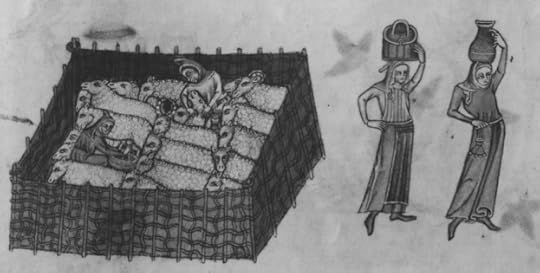
c1100: two women carry jars on their heads as they walk away from a pen crowded with sheep. (Photo by Hulton Archive/Getty Images)
At this point, the balladeer takes a breather, calling for a well-earned drink: “Then you shall hear the best bit,” he (or maybe she) says. We can imagine what this will be. Will the husband make a mess of everything in his wife’s absence? Will she have proved her point about how hard women have to work in the home?
Sadly, our imagination is all we have, because the rest of the ballad is missing: we never get to hear the “best bit”, as promised. Perhaps there never was any more to the ballad, the singer having achieved his/her aim of showing a housewife’s worth.
It seems, then, that Thomas Tusser got it right: “Housewives’ affairs have never an end.” My mother would have agreed with him.
Toni Mount’s The Medieval Housewife and Other Women of the Middle Ages (2014) is available from Amberley Publishing. To find out more, click here.
 Woodcut of a woman stoking a furnace or baking bread, 1497. (Photo by SSPL/Getty Images)
Woodcut of a woman stoking a furnace or baking bread, 1497. (Photo by SSPL/Getty Images) Here, writing for History Extra, Toni Mount, author of The Medieval Housewife and Other Women of the Middle Ages, reveals what life was like for a typical housewife in the Middle Ages.
“A woman’s work is never done!” as my mother used to say in the 1960s, when she cared for our family of five and assorted pets, while working as a school dinner lady. Yet this claim was expressed centuries earlier when the Tudor writer and poet Thomas Tusser wrote in his A Hundreth Good Pointes of Husbandrie in 1557:
Some respite to husbands the weather may send,
But housewives’ affairs have never an end.
We can only imagine the drudgery of struggling to do the washing, cooking and cleaning when every task had to be done from scratch – before the linen could be washed, the housewife had to make the lye (the medieval equivalent of detergent) to soak it in, and before dinner could be cooked, the fire had to be lit. The medieval housewife also had to churn butter, brew ale and tend livestock, as well as spin and weave cloth to make clothes for the family.
These tasks had been carried out by housewives for centuries, but how do we know this, and what evidence do we have? Archaeologists have unearthed quern stones for milling grain at home, and found household utensils to give us a few clues. But many medieval women couldn’t read or write, so they never kept diaries or journals telling us about their everyday lives – they would probably have been too busy to find the time for writing, even if they were able.
In the late 14th century, a grey-haired Frenchman, Guy de Montigny, known as ‘the Goodman of Paris’, wrote a detailed instruction book for his young bride [believed to have been around the age of 15] describing her future duties as a housewife. The couple was of the merchant class and, obviously, the girl must have been literate, as she could read his book.
We may shudder at the idea, but an elderly man marrying a teenager was thought to be beneficial to both parties: he got a new lease of life, and she enjoyed the fruits of his successful career and wisdom. Also, a young woman’s first marriage was normally arranged for her – her husband chosen by the family. However, in certain circumstances a widow might be able to choose her second husband. Guy de Montigny admits this, declaring that, if his wife is well trained in her duties, when she marries again after his death she will be a credit to his teaching. This is how he expects her to care for him:
Wherefore love your husband’s person carefully, and I pray you keep him in clean linen, for ‘tis your business... he is upheld by the hope that he hath of the care which his wife will take of him on his return [home]... to be unshod before a good fire, to have his feet washed and fresh shoes and hose, to be given good food and drink, to be well served and well looked after, well bedded in white sheets and nightcaps, well covered with good furs, and assuaged with other joys and desports, privities, loves and secrets whereof I am silent. And the next day fresh shirts and garments. Certes, such services make a man love and desire to return home and to see his goodwife, and to be distant with others.

Women cutting pig's trotters. From Tacuinum Sanitatis, a medieval handbook of health (14th century). Miniature. Fol. 78 r. (Photo by: Prisma/UIG via Getty Images)
According to William Langland, who wrote Piers Plowman in the 14th century, there are three things that can drive a man from his home, possibly into another woman’s arms – a leaking roof, a smoking fire and, worst of all, “a shrewish wife who will not be chastised; her mate flees for fear of her tongue...”
On the subject of how a housewife ought to behave, an anonymous verse, known as How the Good Wif taughte hir Doughtir, has down-to-earth instructions for young women, to help them to capture better husbands by behaving suitably:
When you sit in the church, your prayers you shall offer.
Make you no chattering to friend or relation.
Laugh you to scorn neither old folk nor young,
But be of fair bearing and of good tongue...
Go you not into town as if you were a flighty person
From one house to another in search of vain amusement;
And go not to market your burrel [cheap, home-spun cloth] to sell,
And then to the tavern to destroy your reputation...
Go not to wrestlings, nor to shooting at cock,
As if you were a strumpet or a wanton woman.
Stay at home daughter, and love your work much,
And so you shall, my dear child, soon grow rich.
For a rough guide to what life was like for a housewife of the lower class, we can refer to an intriguing 15th-century poem, based on a much earlier text, called the Ballad of a Tyrannical Husband, which gives us some idea of how a poor woman’s work was certainly never done:
The goodman [husband] and his lad to the plough are gone,
The goodwife had much to do, and servant had she none,
Many small children to look after beside herself alone,
She did more than she could inside her own house.
Home came the goodman early in the day
To see that everything was according to his wishes.
“Dame,” he said, “is our dinner ready?” “Sir,” she said, “nay.
How would you have me do more than I can?”
Then he began to chide and said, “Damn thee!
I wish you would go all day to plough with me,
To walk in the clods that are wet and boggy,
Then you would know what a ploughman be.”
Then the goodwife swore, and thus she say,
“I have more to do than ever I may.
If you were to follow me for a day,
You would be weary of your part, I bet my head on it.”
“Weary! In the devil’s name!” said the goodman,
“What have you to do, but sit here at home?
You go to your neighbour’s house, one after the other,
And sit there chattering with Jack and with John.”

Woodcut showing a man being de-loused; three lice can be seen around the bowl. Illustration from Hortus Sanitatis (Garden of Health), printed by Johann Pruss in Strasbourg in 1497. (Photo by SSPL/Getty Images)
The goodwife then tells him how she had hardly any sleep last night because of the baby, yet she was first up in the morning to milk the cows and take them out to pasture while he was still asleep. Then she spends the day making butter and cheese and tending the children. She has to feed the chickens, ducks and geese, and take them onto the green. She bakes and brews and prepares flax for weaving. She teases, cards and spins wool.
Her husband then complains that she brews and bakes more often than necessary – once a fortnight would be enough. She laughs. She goes on to explain how she makes the linen and woollen cloth for the family’s clothes so they don’t have the huge expense of buying cloth from the market. She prepares food for the animals:
“…And food for ourselves before it is noon,
Yet I don’t get a fair word when I have done
So I look to our welfare both outdoors and inside
So that nothing great or small is lacking…”
However, this ballad was written to entertain the audience. It has even been suggested that it may have been composed by a woman for a female audience, but this isn’t certain. Then we come to the fun part: the goodman insists that, if his wife believes she labours long and hard, the next day they will swap places and she can try her hand at ploughing, to see what real work entails:
“Therefore, dame, make you ready, I warn you now,
Tomorrow with my lad, you shall go to the plough
And I shall be the housewife and keep our house and home
And take my ease, as you do, by God and Saint John!”
The wife agrees to the challenge, listing all the jobs he will have to do. Just to be sure the family won’t go hungry the next day, the wife gets up extra early to milk the cow and churn the butter, putting the meat to marinade for dinner. All the husband will have to do is care for the children “and let them not weep”, see the geese don’t wander off, and make sure the malt (for making ale), being heated in the oven, doesn’t burn. Can he manage that? “Teach me no more housewifery, I know enough,” he tells her.

c1100: two women carry jars on their heads as they walk away from a pen crowded with sheep. (Photo by Hulton Archive/Getty Images)
At this point, the balladeer takes a breather, calling for a well-earned drink: “Then you shall hear the best bit,” he (or maybe she) says. We can imagine what this will be. Will the husband make a mess of everything in his wife’s absence? Will she have proved her point about how hard women have to work in the home?
Sadly, our imagination is all we have, because the rest of the ballad is missing: we never get to hear the “best bit”, as promised. Perhaps there never was any more to the ballad, the singer having achieved his/her aim of showing a housewife’s worth.
It seems, then, that Thomas Tusser got it right: “Housewives’ affairs have never an end.” My mother would have agreed with him.
Toni Mount’s The Medieval Housewife and Other Women of the Middle Ages (2014) is available from Amberley Publishing. To find out more, click here.
Published on August 14, 2016 03:00



